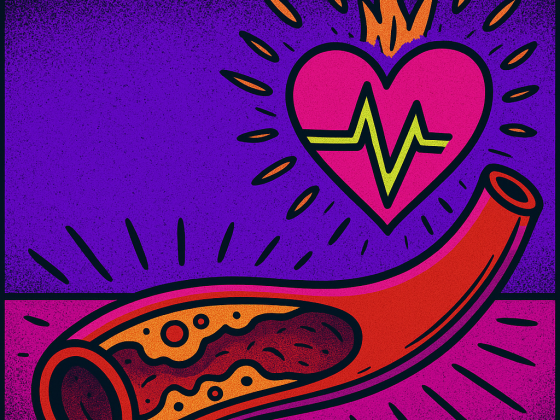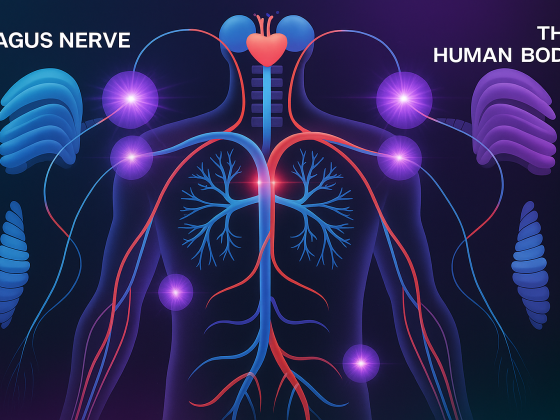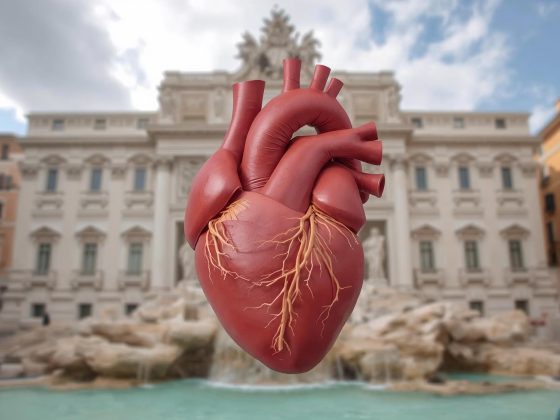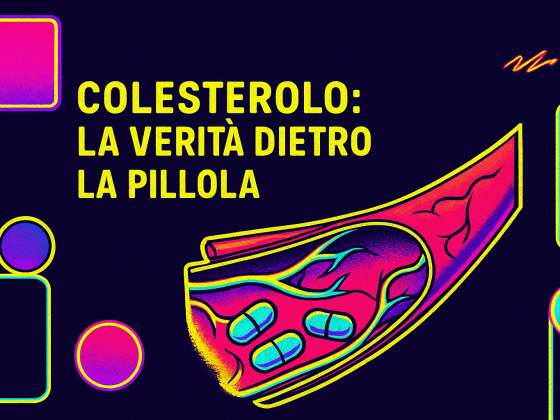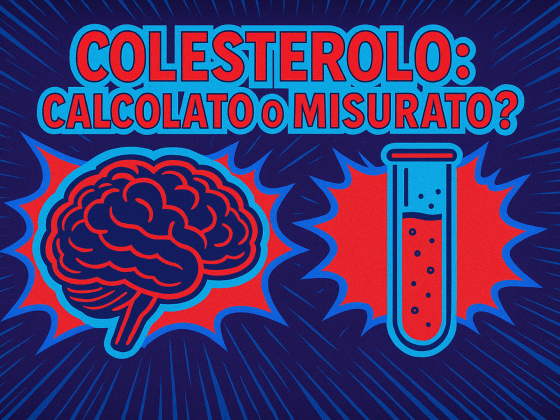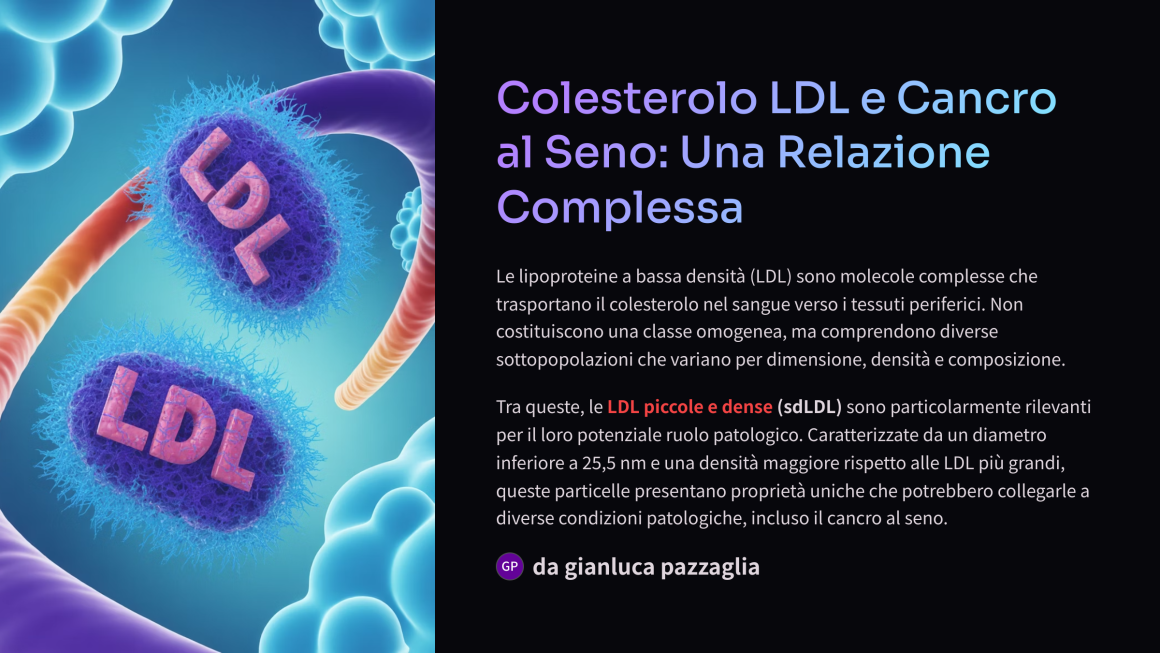
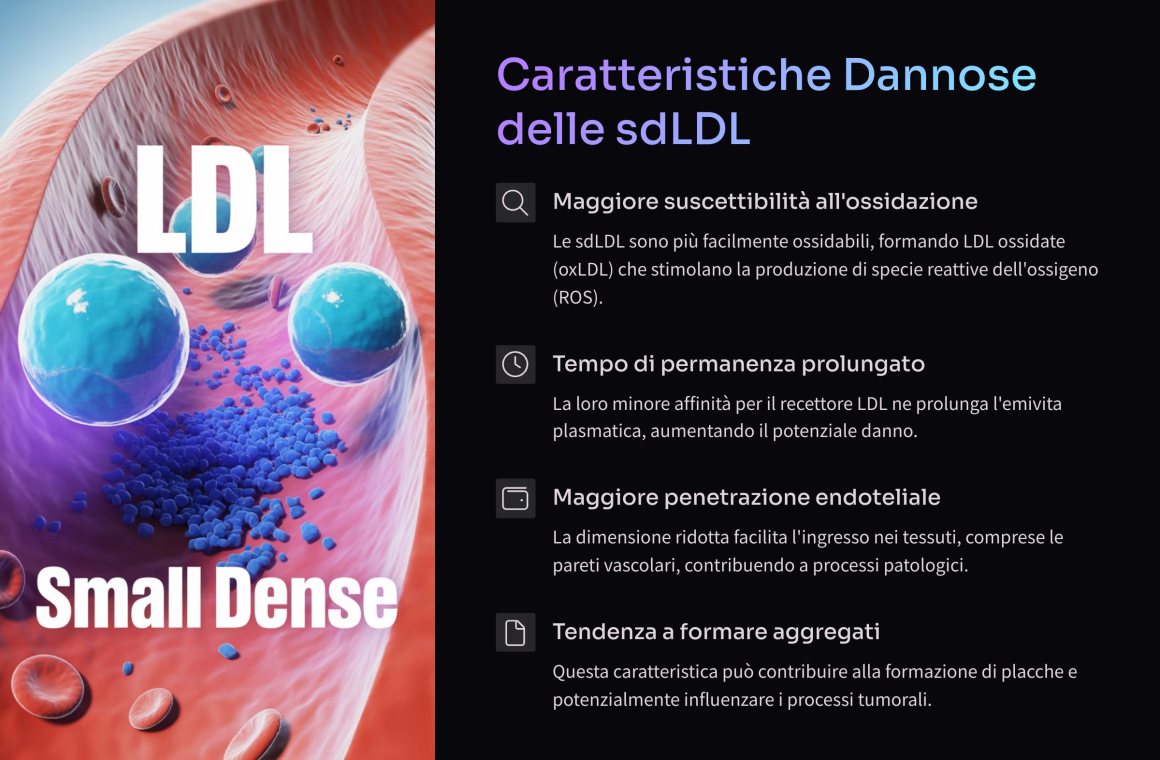
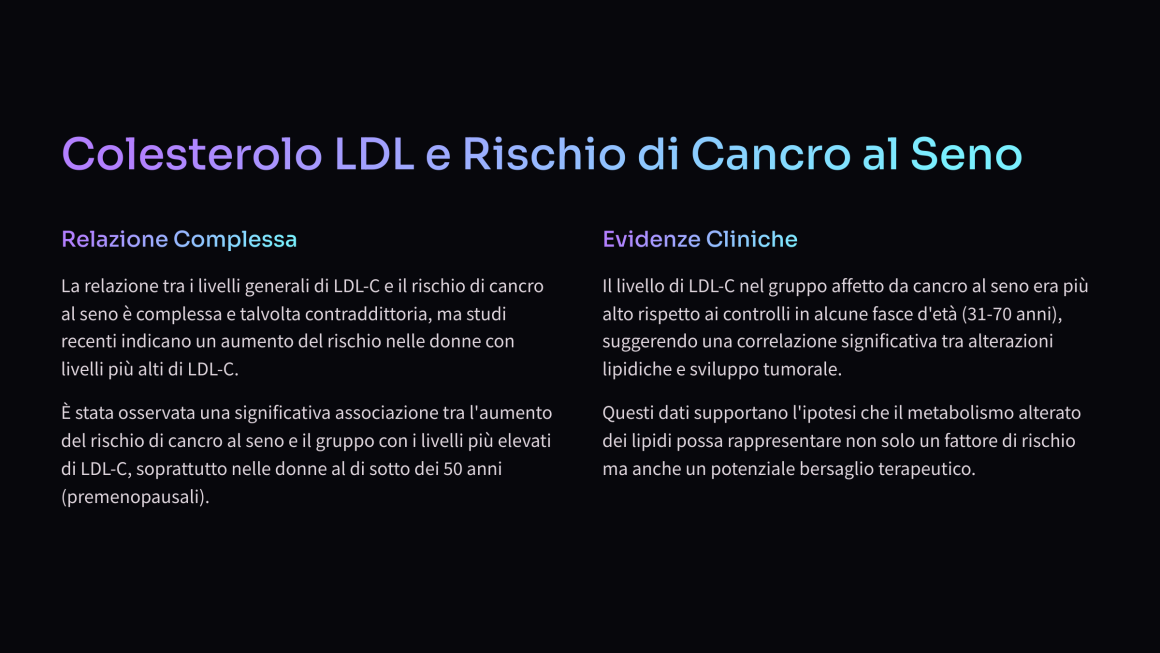
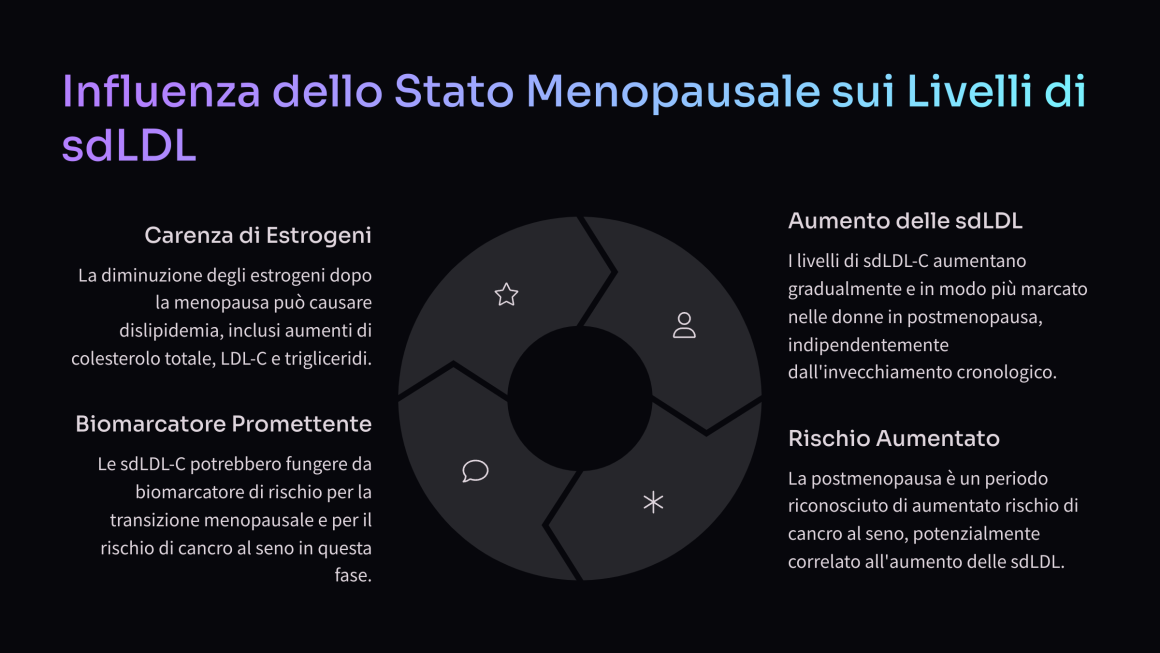
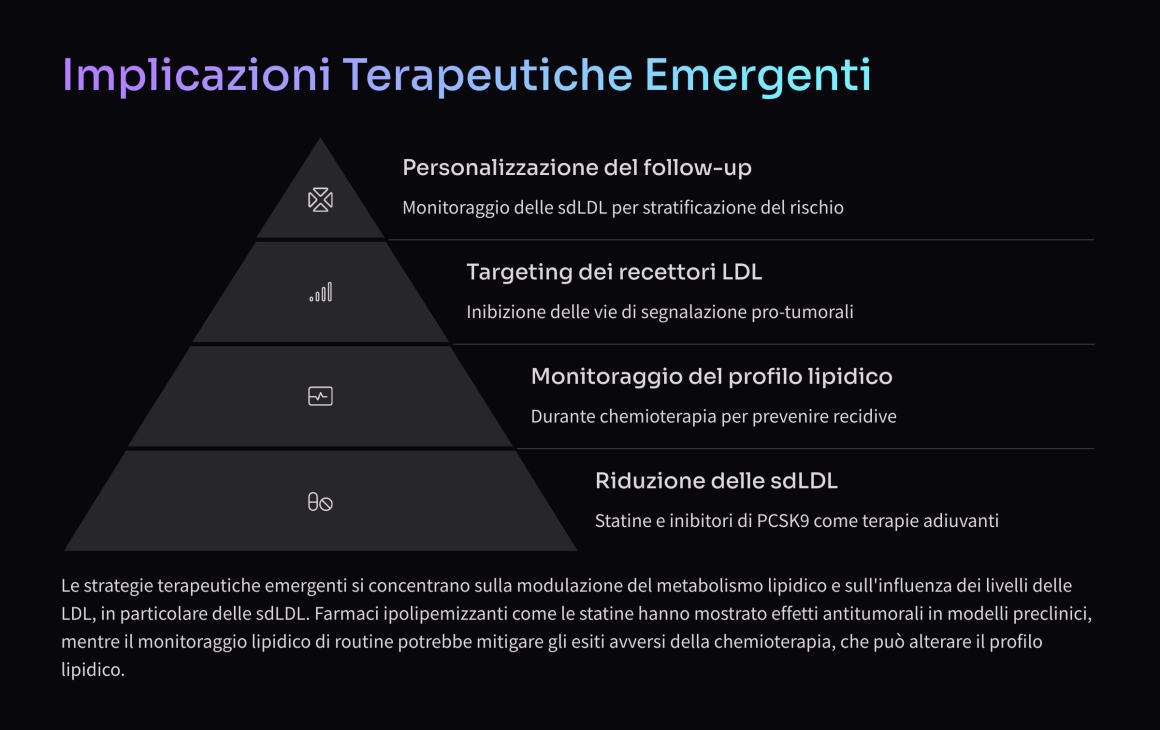
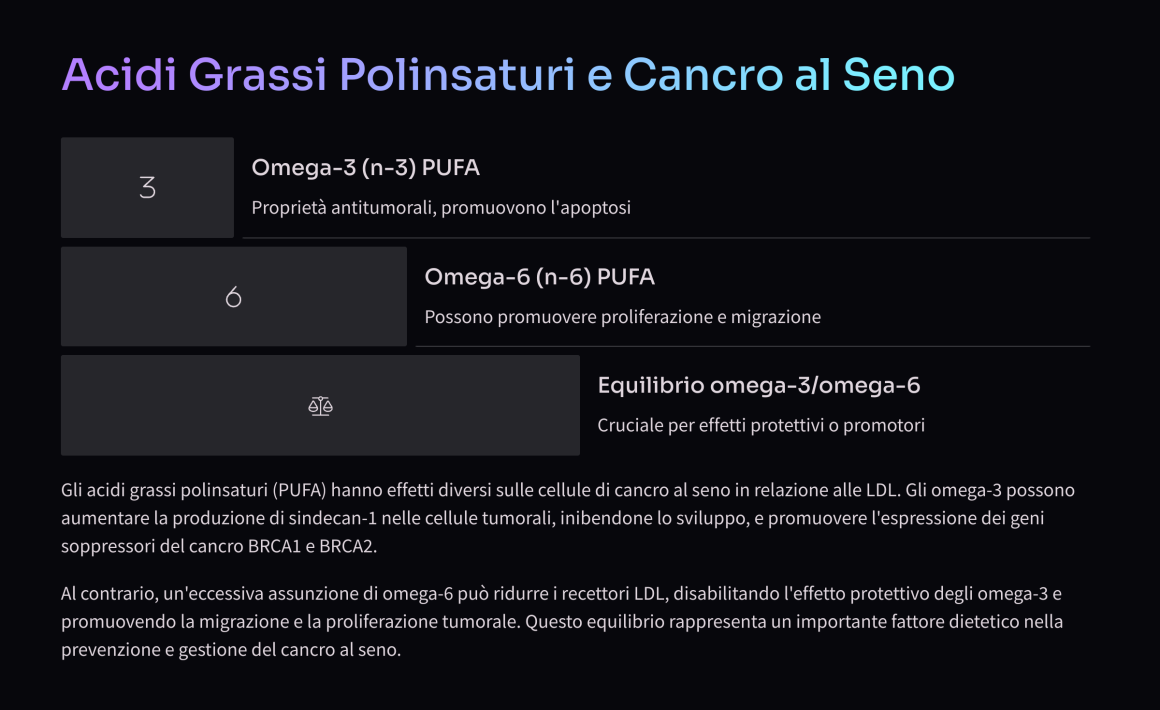
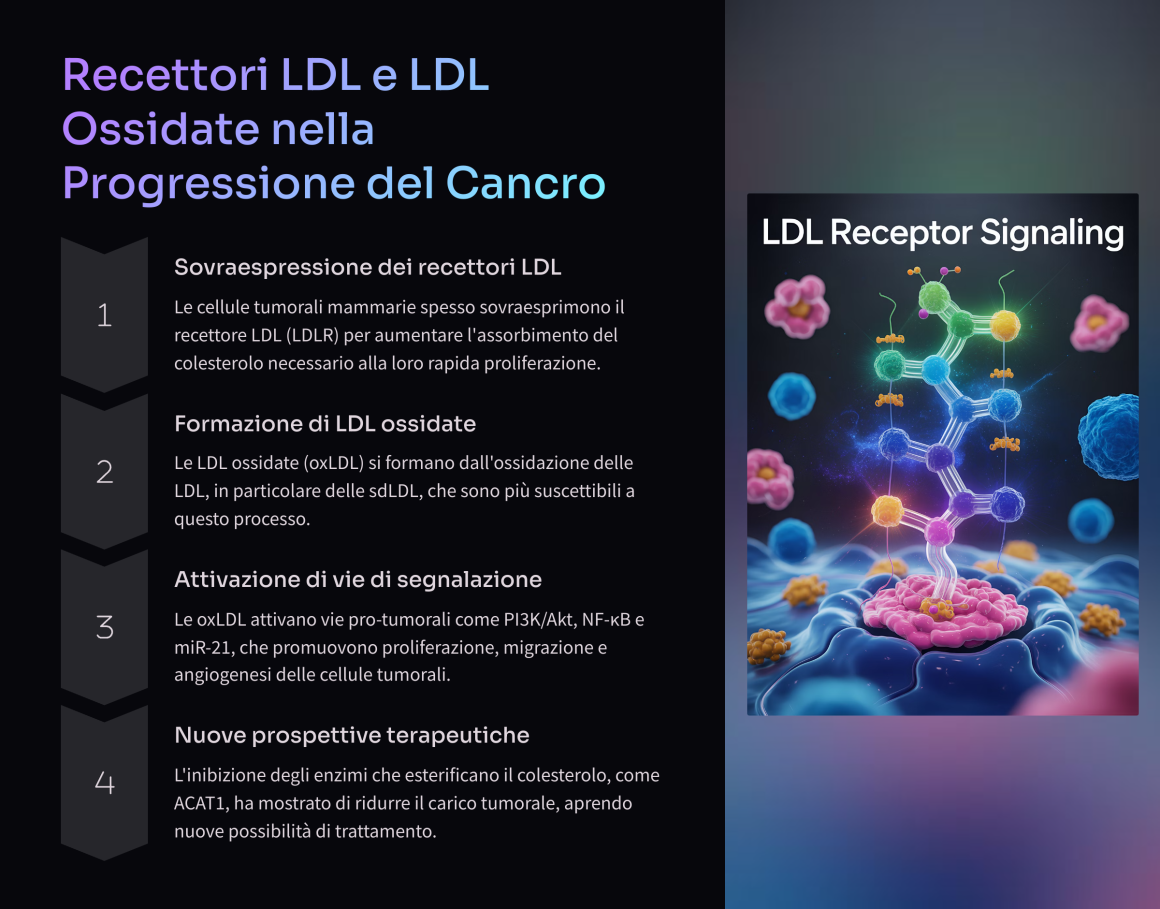
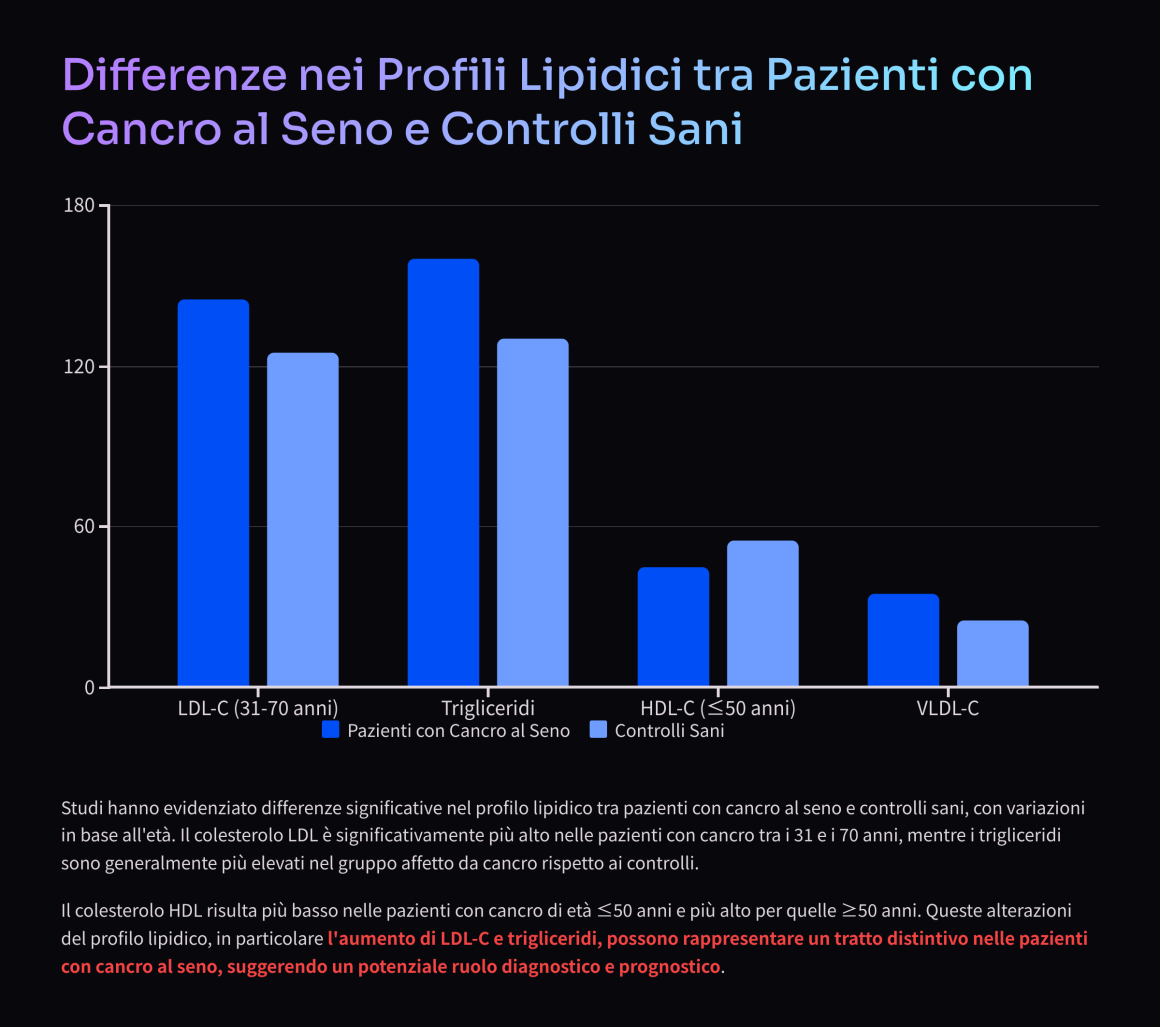
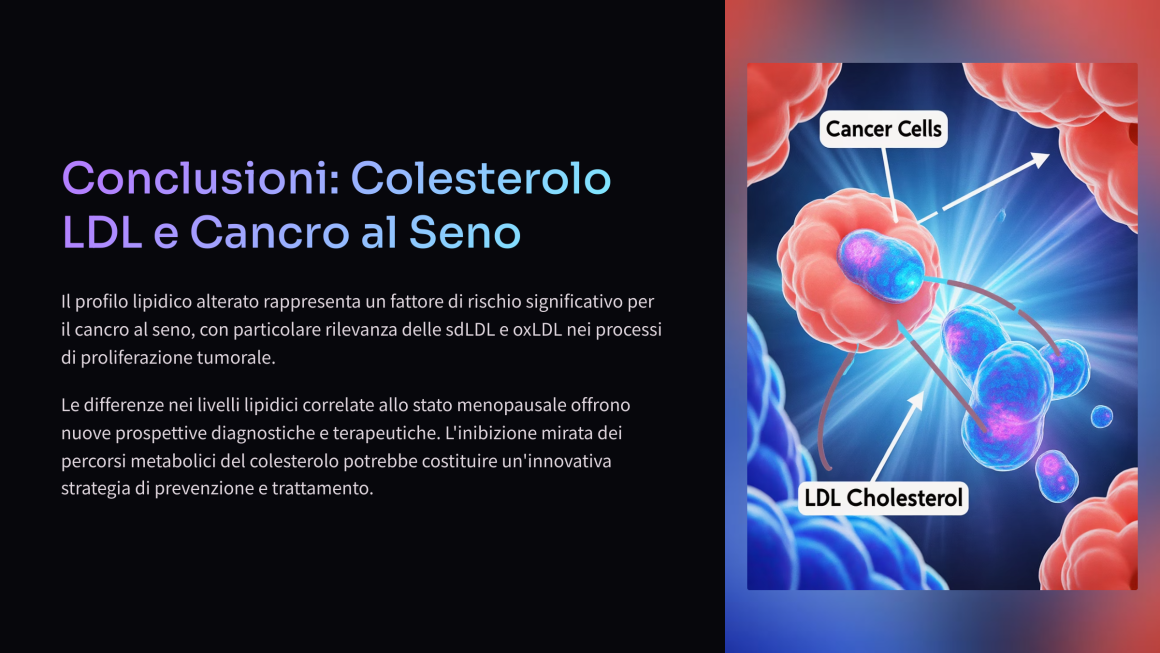
Se ti è piaciuto questo articolo:
ISCRIVITI ALLA NEWSLETTER
BIBLIOGRAFIA
Heer E, Harper A, Escandor N, Sung H, McCormack V, Fidler-Benaoudia MM (2020) Global burden and trends in premenopausal and postmenopausal breast cancer: a population-based study. Lancet Glob Health 8(8):e1027–e1037.
Kuzu OF, Noory MA, Robertson GP (2016) The role of cholesterol in cancer. Cancer Res 76(8):2063–2070.
Ni H, Liu H, Gao R (2015) Serum lipids and breast cancer risk: a meta-analysis of prospective cohort studies. PLoS ONE 10(11):e0142669.
Touvier M, Fassier P, His M, Norat T, Chan DS, Blacher J et al (2015) Cholesterol and breast cancer risk: a systematic review and meta-analysis of prospective studies. Br J Nutr 114(3):347–357.
Nowak C, Ärnlöv J (2018) A Mendelian randomization study of the effects of blood lipids on breast cancer risk. Nat Commun 9(1):3957.
Qi G, Chatterjee N (2019) Mendelian randomization analysis using mixture models for robust and efficient estimation of causal effects. Nat Commun 10(1):1941.
Johnson KE, Siewert KM, Klarin D, Damrauer SM, Program VAMV, Chang KM et al (2020) The relationship between circulating lipids and breast cancer risk: a Mendelian randomization study. PLoS Med 17(9):e1003302.
Orho-Melander M, Hindy G, Borgquist S, Schulz CA, Manjer J, Melander O et al (2018) Blood lipid genetic scores, the HMGCR gene and cancer risk: a
Mendelian randomization study. Int J Epidemiol 47(2):495–505.
Sung H, Ferlay J, Siegel RL, Laversanne M, Soerjomataram I, Jemal A et al (2021) Global Cancer Statistics 2020: GLOBOCAN estimates of incidence and mortality worldwide for 36 cancers in 185 countries. CA Cancer J Clin 71(3):209–249.
Itoh H, Kaneko H, Okada A, Yano Y, Morita K, Seki H et al (2021) Fasting plasma glucose and incident colorectal cancer: analysis of a Nationwide Epidemiological Database. J Clin Endocrinol Metab 106(11):e4448–e4458.
Ogawa T, Takahashi H, Saito H, Sagawa M, Aoki D, Matsuda K et al (2023) Novel algorithm for the estimation of cancer incidence using claims data in Japan: a feasibility study. JCO Glob Oncol 9:e2200222.
de Luise C, Sugiyama N, Morishima T, Higuchi T, Katayama K, Nakamura S et al (2021) Validity of claims-based algorithms for selected cancers in Japan: results from the VALIDATE-J study. Pharmacoepidemiol Drug Saf 30(9):1153–1161.
Sato I, Yagata H, Ohashi Y (2015) The accuracy of Japanese claims data in identifying breast cancer cases. Biol Pharm Bull 38(1):53–57.
Hirayama S, Miida T. Small dense LDL: An emerging risk factor for cardiovascular disease. Clinica chimica acta, 2012.
Guan X, et al. Emerging roles of low-density lipoprotein in the development and treatment of breast cancer. Lipids in Health and Disease, 2019.
HDL and LDL: Potential New Players in Breast Cancer Development. Journal of Clinical Medicine, 2019.
Wakatsuki A, et al. Size and Oxidative Susceptibility of Low-Density Lipoprotein Particles in Breast Cancer Patients with Tamoxifen-Induced Fatty Liver. The Journal of Clinical Endocrinology & Metabolism, 2002.
Debik J, et al. Lipoprotein and metabolite associations to breast cancer risk in the HUNT2 study. British Journal of Cancer, 2022.
Mazzuferi G, et al. High density lipoproteins and oxidative stress in breast cancer. Lipids in Health and Disease, 2021.
High atherogenic index of plasma and cardiovascular risk factors among Ghanaian women diagnosed with breast cancer. BMC Research Notes, 2021.
Cedo L, Reddy ST, Mato E, Blanco-Vaca F, Escola-Gil JC. HDL and lDL: potential new players in breast cancer development. J Clin Med. (2019) 8:853. doi: 10.3390/jcm8060853.
Gallagher EJ, Zelenko Z, Neel BA, Antoniou IM, Rajan L, Kase N, et al. Elevated tumor lDLR expression accelerates lDL cholesterol-mediated breast cancer growth inmousemodels of hyperlipidemia.Oncogene. (2017) 36:6462– 6471. doi: 10.1038/onc.2017.247.
Berquand A, Meunier M, Thevenard-Devy J, Ivaldi C, Campion O, Dedieu S, et al. A gentle approach to investigate the influence of lRP-1 silencing on the migratory behavior of breast cancer cells by atomic force microscopy and dynamic cell studies. Nanomedicine. (2019) 18:359– 70. doi: 10.1016/j.nano.2018.10.012.
Benes P, Jurajda M, Zaloudik J, Izakovicova-Holla L, Vacha J. C766T low-density lipoprotein receptor-related protein 1 (LRP1) gene polymorphism and susceptibility to breast cancer. Breast Cancer Res. (2003) 5:R77– 81. doi: 10.1186/bcr591.
Asano Y, Takeuchi T, Okubo H, Saigo C, Kito Y, Iwata Y, et al. Nuclear localization of lDL receptor-related protein 1B in mammary gland carcinogenesis. J Mol Med (Berl). (2019) 97:257–68. doi: 10.1007/s00109-018-01732-2.
Gonias SL, Karimi-Mostowfi N, Murray SS, Mantuano E, Gilder AS. Expression of lDL receptor-related proteins (LRPs) in common solid malignancies correlates with patient survival. PLoS ONE. (2017) 12:e0186649. doi: 10.1371/journal.pone.0186649.
Wang Y, Guo L, Feng L, Zhang W, Xiao T, Di X, et al. Single nucleotide variant profiles of viable single circulating tumour cells reveal cTC behaviours in breast cancer. Oncol Rep. (2018) 39:2147–2159. doi: 10.3892/or.2018.6325.
Derocq D, Prebois C, Beaujouin M, Laurent-Matha V, Pattingre S, Smith GK, et al. Cathepsin d is partly endocytosed by the lRP1 receptor and inhibits lRP1-regulated intramembrane proteolysis. Oncogene. (2012) 31:3202–12. doi: 10.1038/onc.2011.501.
Choi J, Cha YJ, Koo JS. Adipocyte biology in breast cancer: from silent bystander to active facilitator. Prog Lipid Res. (2018) 69:11– 20. doi: 10.1016/j.plipres.2017.11.006.
Masson O, Chavey C, Dray C, Meulle A, Daviaud D, Quilliot D, et al. LRP1 receptor controls adipogenesis and is up-regulated in human andmouse obese adipose tissue. PLoS ONE. (2009) 4:e7422. doi: 10.1371/journal.pone.0007422.
Jedrychowski MP, Gartner CA, Gygi SP, Zhou L, Herz J, Kandror KV, et al. Proteomic analysis of gLUT4 storage vesicles reveals lRP1 to be an important vesicle component and target of insulin signaling. J Biol Chem. (2010) 285:104–14. doi: 10.1074/jbc.M109.040428.
Actis Dato V, Chiabrando GA. The role of low-density lipoprotein receptor-related protein 1 in lipid metabolism, glucose homeostasis and inflammation. Int J Mol Sci. (2018) 19:1780. doi: 10.3390/ijms19061780.
El Asmar A, El Rassi Z. Hepatoblastoma in childhood, long term survival achieved: 2 case reports and literature review. Int J Surg Case Rep. (2016) 21:55–8. doi: 10.1016/j.ijscr.2016.02.019.
Vezina A, Charfi C, Zgheib A, Annabi B. Cerebrovascular angiogenic reprogramming upon lRP1 repression: impact on sphingosine-1-Phosphate-Mediated signaling in brain endothelial cell chemotactism. Mol Neurobiol. (2018) 55:3551–63. doi: 10.1007/s12035-017-0614-3.
Zhao Y, Li D, Zhao J, Song J, Zhao Y. The role of the low-density lipoprotein receptor-related protein 1 (LRP-1) in regulating blood-brain barrier integrity. Rev Neurosci. (2016) 27:623–34. doi: 10.1515/revneuro-2015-0069.
Thomas FC, Taskar K, Rudraraju V, Goda S, Thorsheim HR, Gaasch JA, et al. Uptake of aNG1005, a novel paclitaxel derivative, through the blood-brain barrier into brain and experimental brain metastases of breast cancer. Pharm Res. (2009) 26:2486–94. doi: 10.1007/s11095-009-9964-5.
Depau L, Brunetti J, Falciani C, Scali S, Riolo G, Mandarini E, et al. Coupling to a cancer-selective heparan-sulfate-targeted branched peptide can by-pass breast cancer cell resistance to methotrexate. Oncotarget. (2017) 8:76141– 152. doi: 10.18632/oncotarget.19056.
Falciani C, Fabbrini M, Pini A, Lozzi L, Lelli B, Pileri S, et al. Synthesis and biological activity of stable branched neurotensin peptides for tumor targeting. Mol Cancer Ther. (2007) 6:2441– 8. doi: 10.1158/1535-7163.MCT-07-0164.
Falciani C, Brunetti J, Pagliuca C, Menichetti S, Vitellozzi L, Lelli B, et al. Design and in vitro evaluation of branched peptide conjugates: turning nonspecific cytotoxic drugs into tumor-selective agents. ChemMedChem. (2010) 5:567–74. doi: 10.1002/cmdc.200900527.
Brunetti J, Pillozzi S, Falciani C, Depau L, Tenori E, Scali S, et al. Tumor-selective peptide-carrier delivery of paclitaxel increases in vivo activity of the drug. Sci Rep. (2015) 5:17736. doi: 10.1038/srep17736.
Lu W, Lin C, Roberts MJ, Waud WR, Piazza GA, Li Y. Niclosamide suppresses cancer cell growth by inducing wnt co-receptor lRP6 degradation and inhibiting the wnt/beta-catenin pathway. PLoS ONE. (2011) 6:e29290. doi: 10.1371/journal.pone.0029290.
Reiner AS, Sisti J, John EM, et al. Breast Cancer family history and contralateral breast Cancer risk in young women: an update from the Women’s environmental Cancer and radiation epidemiology study. J Clin Oncol. 2018;36(15):1513–20.
Blucher C, Stadler SC. Obesity and breast Cancer: current insights on the role of fatty acids and lipid metabolism in promoting breast Cancer growth and progression. Front Endocrinol (Lausanne). 2017;8:293.
Madssen TS, Thune I, Flote VG, et al. Metabolite and lipoprotein responses and prediction of weight gain during breast cancer treatment. Br J Cancer. 2018;119(9):1144–54.
Akalanka H, Ekanayake S, Samarasinghe K. Could anthropometric and lipid parameters reflect susceptibility to breast Cancer? Comparison of newly diagnosed breast Cancer and apparently healthy women. Asian Pac J Cancer Prev. 2018;19(9):2475–80.
Douste-Blazy P. Metabolism of cholesterol: the LDL receptor pathway. Arch Mal Coeur Vaiss. 1987;80:17–22.
Dos SC, Domingues G, Matias I, et al. LDL-cholesterol signaling induces
breast cancer proliferation and invasion. Lipids Health Dis. 2014;13:16.
Cortese C, Turner PR, Marenah CB, et al. Lack of correlation between the maximum low-density lipoprotein (LDL) receptor activity of blood lymphocytes and plasma LDL concentration in normal men. Clin Sci (Lond). 1983;65(1):95–8.
Hagander B, Asp NG, Efendic S, Nilsson-Ehle P, Schersten B. Dietary fiber decreases fasting blood glucose levels and plasma LDL concentration in noninsulin-dependent diabetes mellitus patients. Am J Clin Nutr. 1988;47(5): 852–8.
Sharma S, Mazumdar S, Italiya KS, et al. Cholesterol and Morpholine grafted cationic Amphiphilic copolymers for miRNA-34a delivery. Mol Pharm. 2018; 15(6):2391–402.
Mazumdar S, Italiya KS, Sharma S, Chitkara D, Mittal A. Effective cellular internalization, cell cycle arrest and improved pharmacokinetics of Tamoxifen by cholesterol based lipopolymeric nanoparticles. Int J Pharm. 2018;543(1–2):96–106.
Kumar V, Singh A, Sidhu DS, Panag KM. A comparitive study to evaluate the role of serum lipid levels in aetiology of carcinoma breast. J Clin Diagn Res. 2015;9(2):C1–3.
Ooi EM, Watts GF, Ng TW, Barrett PH. Effect of dietary Fatty acids on human lipoprotein metabolism: a comprehensive update. Nutrients. 2015;7(6):4416–25.
Shaikh S, Channa NA, Talpur FN, Younis M, Tabassum N. Radiotherapy improves serum fatty acids and lipid profile in breast cancer. Lipids Health Dis. 2017;16(1):92.
Ozmen HK, Erdemci B, Askin S, Sezen O. Carnitine and Adiponectin levels in breast Cancer after radiotherapy. Open med (wars). 2017;12:189–94.
Wolfe AR, Atkinson RL, Reddy JP, et al. High-density and very-low-density lipoprotein have opposing roles in regulating tumor-initiating cells and sensitivity to radiation in inflammatory breast cancer. Int J Radiat Oncol Biol Phys. 2015;91(5):1072–80.
Lyu J, Yang EJ, Shim JS. Cholesterol Trafficking: An Emerging Therapeutic Target for Angiogenesis and Cancer. Cells (2019) 8(5):389. doi: 10.3390/ cells8050389.
Murai T. Cholesterol Lowering: Role in Cancer Prevention and Treatment. Biol Chem (2015) 396(1):1–11. doi: 10.1515/hsz-2014-0194.
Allott EH, Howard LE, Cooperberg MR, Kane CJ, Aronson WJ, Terris MK, et al. Serum Lipid Profile and Risk of Prostate Cancer Recurrence: Results From the SEARCH Database. Cancer Epidemiol Biomarkers Prev (2014) 23 (11):2349–56. doi: 10.1158/1055-9965.EPI-14-0458.
Huang B, Song BL, Xu C. Cholesterol Metabolism in Cancer: Mechanisms and Therapeutic Opportunities. Nat Metab (2020) 2(2):132–41. doi: 10.1038/s42255-020-0174-0.
Beckwitt CH, Brufsky A, Oltvai ZN, Wells A. Statin Drugs to Reduce Breast Cancer Recurrence and Mortality. Breast Cancer Res: BCR (2018) 20(1):144. doi: 10.1186/s13058-018-1066-z.
Akinwunmi B, Vitonis AF, Titus L, Terry KL, Cramer DW. Statin Therapy and Association With Ovarian Cancer Risk in the New England Case Control (NEC) Study. Int J Cancer (2019) 144(5):991–1000. doi: 10.1002/ ijc.31758.
Zhou M, Zheng J, Bi J, Wu X, Lyu J, Gao K. Synergistic Inhibition of Colon Cancer Cell Growth by a Combination of Atorvastatin and Phloretin. Oncol Lett (2018) 15(2):1985–92. doi: 10.3892/ol.2017.7480.
Nielsen SF, Nordestgaard BG, Bojesen SE. Statin Use and Reduced Cancer-Related Mortality. New Engl J Med (2012) 367(19):1792–802. doi: 10.1056/ NEJMoa1201735.
Xu H, Zhou S, Tang Q, Xia H, Bi F. Cholesterol Metabolism: New Functions and Therapeutic Approaches in Cancer. Biochim Biophys Acta Rev Cancer (2020) 1874(1):188394. doi: 10.1016/j.bbcan.2020.188394.
Nazih H, Bard JM. Cholesterol, Oxysterols and LXRs in Breast Cancer Pathophysiology. Int J Mol Sci (2020) 21(4):1356. doi: 10.3390/ ijms21041356.
Inoue M, Niki M, Ozeki Y, Nagi S, Chadeka EA, Yamaguchi T, et al. High-Density Lipoprotein Suppresses Tumor Necrosis Factor Alpha Production by Mycobacteria-Infected Human Macrophages. Sci Rep (2018) 8(1):6736. doi: 10.1038/s41598-018-24233-1.
Guo D, Bell EH, Mischel P, Chakravarti A. Targeting SREBP-1-Driven Lipid Metabolism to Treat Cancer. Curr Pharm Des (2014) 20(15):2619–26. doi: 10.2174/13816128113199990486.
Siemianowicz K, Gminski J, Stajszczyk M, Wojakowski W, Goss M, Machalski M, et al. Serum LDL Cholesterol Concentration and Lipoprotein Electrophoresis Pattern in Patients With Small Cell Lung Cancer. Int J Mol Med (2000) 5(1):55–7. doi: 10.3892/ijmm.5.1.55.
Sottero B, Gargiulo S, Russo I, Barale C, Poli G, Cavalot F. Postprandial Dysmetabolism and Oxidative Stress in Type 2 Diabetes: Pathogenetic Mechanisms and Therapeutic Strategies. Med Res Rev (2015) 35(5):968– 1031. doi: 10.1002/med.21349.
Negre-Salvayre A, Coatrieux C, Ingueneau C, Salvayre R. Advanced Lipid Peroxidation End Products in Oxidative Damage to Proteins. Potential Role in Diseases and Therapeutic Prospects for the Inhibitors. Br J Pharmacol (2008) 153(1):6–20. doi: 10.1038/sj.bjp.0707395.
Balzan S, Lubrano V. LOX-1 Receptor: A Potential Link in Atherosclerosis and Cancer. Life Sci (2018) 198:79–86. doi: 10.1016/j.lfs.2018.02.024.
González-Chavarrıá I, Fernandez E, Gutierrez N, González-Horta EE, Sandoval F, Cifuentes P, et al. LOX-1 Activation by oxLDL Triggers an Epithelial Mesenchymal Transition and Promotes Tumorigenic Potential in Prostate Cancer Cells. Cancer Lett (2018) 414:34–43. doi: 10.1016/ j.canlet.2017.10.035.
Ma C, Xie J, Luo C, Yin H, Li R, Wang X, et al. OxLDL Promotes Lymphangiogenesis and Lymphatic Metastasis in Gastric Cancer by Upregulating VEGF−C Expression and Secretion. Int J Oncol (2019) 54 (2):572–84. doi: 10.3892/ijo.2018.4648.
Swinnen JV, Brusselmans K, Verhoeven G. Increased Lipogenesis in Cancer Cells: New Players, Novel Targets. Curr Opin Clin Nutr Metab Care (2006) 9 (4):358–65. doi: 10.1097/01.mco.0000232894.28674.30.
Chakraborty S, Cai Y, Tarr MA. In Vitro Oxidative Footprinting Provides Insight Into Apolipoprotein B-100 Structure in Low-Density Lipoprotein. Proteomics (2014) 14(21-22):2614–22. doi: 10.1002/pmic.201300174.
Loregger A, Nelson JK, Zelcer N. Assaying Low-Density-Lipoprotein (LDL) Uptake Into Cells. Methods Mol Biol (Clifton NJ) (2017) 1583:53–63. doi: 10.1007/978-1-4939-6875-6_5.
Jeon TI, Osborne TF. miRNA and Cholesterol Homeostasis. Biochim Biophys Acta (2016) 1861(12 Pt B):2041–6. doi: 10.1016/j.bbalip.2016.01.005.
Peng C, Lei P, Li X, Xie H, Yang X, Zhang T, et al. Down-Regulated of SREBP-1 in Circulating Leukocyte is a Risk Factor for Atherosclerosis: A Case Control Study. Lipids Health Dis (2019) 18(1):177. doi: 10.1186/ s12944-019-1125-1.
Afonso MS, Machado RM, Lavrador MS, Quintao ECR, Moore KJ, Lottenberg AM. Molecular Pathways Underlying Cholesterol Homeostasis. Nutrients (2018) 10(6):760. doi: 10.3390/nu10060760.
Madison BB. Srebp2: A Master Regulator of Sterol and Fatty Acid Synthesis. J Lipid Res (2016) 57(3):333–5. doi: 10.1194/jlr.C066712.
Lagace TA. PCSK9 and LDLR Degradation: Regulatory Mechanisms in Circulation and in Cells. Curr Opin Lipidol (2014) 25(5):387–93. doi: 10.1097/MOL.0000000000000114.
Seidah NG. The PCSK9 Revolution and the Potential of PCSK9-Based Therapies to Reduce LDL-Cholesterol. Global Cardiol Sci Pract (2017) 2017(1):e201702. doi: 10.21542/gcsp.2017.2.
Huang M, Zhao Z, Cao Q, You X, Wei S, Zhao J, et al. PAQR3 Modulates Blood Cholesterol Level by Facilitating Interaction Between LDLR and PCSK9. Metab: Clin Exp (2019) 94:88–95. doi: 10.1016/j.metabol. 2019.02.005.
Wang Y, Liu ZP. PCSK9 Inhibitors: Novel Therapeutic Strategies for Lowering LDLCholesterol. Mini Rev Med Chem (2019) 19(2):165–76. doi: 10.2174/1389557518666180423111442.
Attie AD. ABCA1: At the Nexus of Cholesterol, HDL and Atherosclerosis. Trends Biochem Sci (2007) 32(4):172–9. doi: 10.1016/j.tibs.2007.02.001.
Zelcer N, Hong C, Boyadjian R, Tontonoz P. LXR Regulates Cholesterol Uptake Through Idol-Dependent Ubiquitination of the LDL Receptor. Sci (New York NY) (2009) 325(5936):100–4. doi: 10.1126/science.1168974.
Chade AR, Lerman A, Lerman LO. Kidney in Early Atherosclerosis. Hypertens (Dallas Tex: 1979) (2005) 45(6):1042–9. doi: 10.1161/ 01.HYP.0000167121.14254.a0.
Morita SY. Metabolism and Modification of Apolipoprotein B-Containing Lipoproteins Involved in Dyslipidemia and Atherosclerosis. Biol Pharm Bull (2016) 39(1):1–24. doi: 10.1248/bpb.b15-00716.
Sukhbold E, Sekimoto S, Watanabe E, Yamazaki A, Yang L, Takasugi M, et al. Effects of Oolonghomobisflavan A on Oxidation of Low-Density Lipoprotein. Biosci Biotechnol Biochem (2017) 81(8):1569–75. doi: 10.1080/09168451.2017.1314758.
Zhang X, Han X, Zhang P, Zhou T, Chen Y, Jin J, et al. Morin Attenuates Oxidized Low-Density Lipoprotein-Mediated Injury by Inducing Autophagy via Activating AMPK Signalling in HUVECs. Clin Exp Pharmacol Physiol (2019) 46(11):1053–60. doi: 10.1111/1440-1681.13160.
Bitorina AV, Oligschlaeger Y, Shiri-Sverdlov R, Theys J. Low Profile High Value Target: The Role of OxLDL in Cancer. Biochim Biophys Acta Mol Cell Biol Lipids (2019) 1864(12):158518. doi: 10.1016/j.bbalip.2019.158518.
Mehta N, Hordines J, Volpe C, Doerr R, Cohen SA. Cellular Effects of Hypercholesterolemia in Modulation of Cancer Growth and Metastasis: A Review of the Evidence. Surg Oncol (1997) 6(3):179–85. doi: 10.1016/S0960-7404(97)00027-3.
Kuzu OF, Noory MA, Robertson GP. The Role of Cholesterol in Cancer. Cancer Res (2016) 76(8):2063–70. doi: 10.1158/0008-5472.CAN-15-2613.
Llaverias G, Danilo C, Mercier I, Daumer K, Capozza F, Williams TM, et al. Role of Cholesterol in the Development and Progression of Breast Cancer. Am J Pathol (2011) 178(1):402–12. doi: 10.1016/j.ajpath.2010.11.005.
Drabkin HA, Gemmill RM. Cholesterol and the Development of Clear-Cell Renal Carcinoma. Curr Opin Pharmacol (2012) 12(6):742–50. doi: 10.1016/j.coph.2012.08.002.
Chen Y, Hughes-Fulford M. Human Prostate Cancer Cells Lack Feedback Regulation of Low-Density Lipoprotein Receptor and Its Regulator, SREBP2. Int J Cancer (2001) 91(1):41–5. doi: 10.1002/1097-0215(20010101)91:1<41:: AID-IJC1009>3.0.CO;2-2.
Diakowska D, Grabowski K, Nienartowicz M, Zarębski P, Fudalej K, Markocka-Mac̨zka K. Circulating Oxidized Low-Density Lipoproteins and Antibodies Against Oxidized Low-Density Lipoproteins as Potential Biomarkers of Colorectal Cancer. Gastroenterol Res Pract (2015) 2015:146819. doi: 10.1155/2015/146819.
Liu Y, Wang Y, Xu Q, Zhou X, Qin Z, Chen C, et al. Prognostic Evaluation of microRNA-210 in Various Carcinomas: Evidence From 19 Studies.Medicine (2017) 96(43):e8113. doi: 10.1097/MD.0000000000008113.
Wu X, Zahari MS, Ma B, Liu R, Renuse S, Sahasrabuddhe NA, et al. Global Phosphotyrosine Survey in Triple-Negative Breast Cancer Reveals Activation of Multiple Tyrosine Kinase Signaling Pathways. Oncotarget (2015) 6(30):29143–60. doi: 10.18632/oncotarget.5020.
Vuong D, Simpson PT, Green B, Cummings MC, Lakhani SR. Molecular Classification of Breast Cancer. Virchows Archiv (2014) 465(1):1–14. doi: 10.1007/s00428-014-1593-7.
Rodrigues Dos Santos C, Fonseca I, Dias S, Mendes de Almeida JC. Plasma level of LDL-cholesterol at diagnosis is a predictor factor of breast tumor progression. BMC Cancer (2014) 14:132. doi: 10.1186/1471-2407-14-132.
Johnson KE, Siewert KM, Klarin D, Damrauer SM, Chang KM, Tsao PS, et al. The Relationship Between Circulating Lipids and Breast Cancer Risk: A Mendelian Randomization Study. PloS Med (2020) 17(9):e1003302. doi: 10.1371/journal.pmed.1003302.
Martin LJ, Melnichouk O, Huszti E, Connelly PW, Greenberg CV, Minkin S, et al. Serum Lipids, Lipoproteins, and Risk of Breast Cancer: A Nested Case-Control Study Using Multiple Time Points. J Natl Cancer Inst (2015) 107(5): djv032. doi: 10.1093/jnci/djv032.
Llanos AA, Makambi KH, Tucker CA, Wallington SF, Shields PG, Adams-Campbell LL. Cholesterol, Lipoproteins, and Breast Cancer Risk in African American Women. Ethnicity Dis (2012) 22(3):281–7.
Taylor AE, Davies NM, Ware JJ, VanderWeele T, Smith GD, Munafò MR. Mendelian Randomization in Health Research: Using Appropriate Genetic Variants and Avoiding Biased Estimates. Econ Hum Biol (2014) 13(100):99– 106. doi: 10.1016/j.ehb.2013.12.002.
de Gonzalo-Calvo D, López-Vilaró L, Nasarre L, Perez-Olabarria M, Vázquez T, Escuin D, et al. Intratumor Cholesteryl Ester Accumulation Is Associated With Human Breast Cancer Proliferation and Aggressive Potential: A Molecular and Clinicopathological Study. BMC Cancer (2015) 15:460. doi: 10.1186/s12885-015-1469-5.
Agnoli C, Grioni S, Sieri S, Sacerdote C, Vineis P, Tumino R, et al. Colorectal Cancer Risk and Dyslipidemia: A Case-Cohort Study Nested in an Italian Multicentre Cohort. Cancer Epidemiol (2014) 38(2):144–51. doi: 10.1016/ j.canep.2014.02.002.
Zhang X, Zhao XW, Liu DB, Han CZ, Du LL, Jing JX, et al. Lipid Levels in Serum and Cancerous Tissues of Colorectal Cancer Patients. World J Gastroenterol (2014) 20(26):8646–52. doi: 10.3748/wjg.v20.i26.8646.
Liao F, He W, Jiang C, Yin C, Guo G, Chen X, et al. A High LDL-C to HDL-C Ratio Predicts Poor Prognosis for Initially Metastatic Colorectal Cancer Patients With Elevations in LDL-C.OncoTargets Ther (2015) 8:3135–42. doi: 10.2147/OTT.S90479.
Notarnicola M, Altomare DF, Correale M, Ruggieri E, D’Attoma B, Mastrosimini A, et al. Serum Lipid Profile in Colorectal Cancer Patients With and Without Synchronous Distant Metastases. Oncology (2005) 68(4-6):371–4. doi: 10.1159/000086977.
Sharma B, Gupta V, Dahiya D, Kumar H, Vaiphei K, Agnihotri N. Clinical Relevance of Cholesterol Homeostasis Genes in Colorectal Cancer. Biochim Biophys Acta Mol Cell Biol Lipids (2019) 1864(10):1314–27. doi: 10.1016/ j.bbalip.2019.06.008.
LaRosa JC. Lipids and Cardiovascular Disease: Do the Findings and Therapy Apply Equally to Men andWomen?Women’s Health Issues (1992) 2(2):102– 11. discussion 11-3. doi: 10.1016/s1049-3867(05)80278-6.
Murdocca M, Mango R, Pucci S, Biocca S, Testa B, Capuano R, et al. The Lectin-Like Oxidized LDL Receptor-1: A New Potential Molecular Target in Colorectal Cancer. Oncotarget (2016) 7(12):14765–80. doi: 10.18632/ oncotarget.7430.
Murdocca M, De Masi C, Pucci S, Mango R, Novelli G, Di Natale C, et al. LOX-1 and Cancer: An Indissoluble Liaison. Cancer Gene Ther (2021) 28(10-11):1088–98. doi: 10.1038/s41417-020-00279-0.
Nakashima-Nakasuga C, Hazama S, Suzuki N, Nakagami Y, Xu M, Yoshida S, et al. Serum LOX-1 is a Novel Prognostic Biomarker of Colorectal Cancer. Int J Clin Oncol (2020) 25(7):1308–17. doi: 10.1007/s10147-020-01673-2.
Murdocca M, Capuano R, Pucci S, Cicconi R, Polidoro C, Catini A, et al. Targeting LOX-1 Inhibits Colorectal Cancer Metastasis in an Animal Model. Front Oncol (2019) 9:927. doi: 10.3389/fonc.2019.00927.
Chen-Zhao X, Hernando O, López M, Sánchez E, Montero A, Garcıá-Aranda M, et al. A Prospective Observational Study of the Clinical and Pathological Impact of Stereotactic Body Radiotherapy (SBRT) as a Neoadjuvant Strategy of Chemoradiation in Pancreatic Cancer. Clin Trans Oncol (2020) 22(9):1499–505. doi: 10.1007/s12094-020-02287-w.
Louvet C, Labianca R, Hammel P, Lledo G, Zampino MG, André T, et al. Gemcitabine in Combination With Oxaliplatin Compared With Gemcitabine Alone in Locally Advanced or Metastatic Pancreatic Cancer: Results of a GERCOR and GISCAD Phase III Trial. J Clin Oncol (2005) 23 (15):3509–16. doi: 10.1200/JCO.2005.06.023.
Maisonneuve P, Lowenfels AB. Epidemiology of Pancreatic Cancer: An Update. Digestive Dis (Basel Switzerland) (2010) 28(4-5):645–56. doi: 10.1159/000320068.
Aune D, Greenwood DC, Chan DS, Vieira R, Vieira AR, Navarro Rosenblatt DA, et al. Body Mass Index, Abdominal Fatness and Pancreatic Cancer Risk: A Systematic Review and non-Linear Dose-Response Meta-Analysis of.
Vasseur S, Guillaumond F. LDL Receptor: An Open Route to Feed Pancreatic Tumor Cells. Mol Cell Oncol (2016) 3(1):e1033586. doi: 10.1080/ 23723556.2015.1033586.
Guillaumond F, Bidaut G, Ouaissi M, Servais S, Gouirand V, Olivares O, et al. Cholesterol Uptake Disruption, in Association With Chemotherapy, Is a Promising Combined Metabolic Therapy for Pancreatic Adenocarcinoma. Proc Natl Acad Sci USA (2015) 112(8):2473–8. doi: 10.1073/pnas.1421601112.
Chen H, Qin S, Wang M, Zhang T, Zhang S. Association Between Cholesterol Intake and Pancreatic Cancer Risk: Evidence From a Meta-Analysis. Sci Rep (2015) 5:8243. doi: 10.1038/srep08243.
Pelton K, Freeman MR, Solomon KR. Cholesterol and Prostate Cancer. Curr Opin Pharmacol (2012) 12(6):751–9. doi: 10.1016/j.coph.2012.07.006.
YuPeng L, YuXue Z, PengFei L, Cheng C, YaShuang Z, DaPeng L, et al. Cholesterol Levels in Blood and the Risk of Prostate Cancer: A Meta-Analysis of 14 Prospective Studies. Cancer Epidemiol Biomarkers Prev (2015) 24(7):1086–93. doi: 10.1158/1055-9965.EPI-14-1329.
His M, Zelek L, Deschasaux M, Pouchieu C, Kesse-Guyot E, Hercberg S, et al. Prospective Associations Between Serum Biomarkers of Lipid Metabolism and Overall, Breast and Prostate Cancer Risk. Eur J Epidemiol (2014) 29 (2):119–32. doi: 10.1007/s10654-014-9884-5.
Bull CJ, Bonilla C, Holly JM, Perks CM, Davies N, Haycock P, et al. Blood Lipids and Prostate Cancer: A Mendelian Randomization Analysis. Cancer Med (2016) 5(6):1125–36. doi: 10.1002/cam4.695.
Magura L, Blanchard R, Hope B, Beal JR, Schwartz GG, Sahmoun AE. Hypercholesterolemia and Prostate Cancer: A Hospital-Based Case-Control Study. Cancer Causes Control (2008) 19(10):1259–66. doi: 10.1007/s10552-008-9197-7.
Tewari R, Chhabra M, Natu SM, Goel A, Dalela D, Goel MM, et al. Significant Association of Metabolic Indices, Lipid Profile, and Androgen Levels With Prostate Cancer. Asian Pac J Cancer Prevent: APJCP (2014) 15 (22):9841–6. doi: 10.7314/APJCP.2014.15.22.9841.
Zhang JQ, Geng H, Ma M, Nan XY, Sheng BW. Metabolic Syndrome Components are Associated With Increased Prostate Cancer Risk. Med Sci Monit (2015) 21:2387–96. doi: 10.12659/MSM.893442.
Murtola TJ, Syvälä H, Pennanen P, Bläuer M, Solakivi T, Ylikomi T, et al. The Importance of LDL and Cholesterol Metabolism for Prostate Epithelial Cell Growth. PloS One (2012) 7(6):e39445. doi: 10.1371/journal.pone.0039445.
Yue S, Li J, Lee SY, Lee HJ, Shao T, Song B, et al. Cholesteryl Ester Accumulation Induced by PTEN Loss and PI3K/AKT Activation.
González-Chavarrıá I, Cerro RP, Parra NP, Sandoval FA, Zuñiga FA, Omazábal VA, et al. Lectin-Like Oxidized LDL Receptor-1 is an Enhancer of Tumor Angiogenesis in Human Prostate Cancer Cells. PloS One (2014) 9 (8):e106219. doi: 10.1371/journal.pone.0106219.
Wettersten HI, Aboud OA, Lara PN Jr, Weiss RH. Metabolic Reprogramming in Clear Cell Renal Cell Carcinoma. Nat Rev Nephrol (2017) 13(7):410–9. doi: 10.1038/nrneph.2017.59.
Zhang GM, Zhu Y, Luo L, Zhang HL, Gu CY, Sun LJ, et al. Prevalence of Dyslipidaemia in Patients With Renal Cell Carcinoma: A Case-Control Study in China. BJU Int (2014) 113(5b):E75–81. doi: 10.1111/bju.12581.
Zhang CJ, Zhu N, Wang YX, Liu LP, Zhao TJ, Wu HT, et al. Celastrol Attenuates Lipid Accumulation and Stemness of Clear Cell Renal Cell Carcinoma via CAV-1/LOX-1 Pathway. Front Pharmacol (2021) 12:658092. doi: 10.3389/fphar.2021.658092.
Zhang C, Yu L, Xu T, Hao Y, Zhang X, Liu Z, et al. Association of Dyslipidemia With Renal Cell Carcinoma: A 1∶2 Matched Case-Control Study. PloS One (2013) 8(3):e59796. doi: 10.1371/journal.pone.0059796.
Wu G, Wang Q, Xu Y, Li J, Zhang H, Qi G, et al. Targeting the Transcription Factor Receptor LXR to Treat Clear Cell Renal Cell Carcinoma: Agonist or Inverse Agonist? Cell Death Dis (2019) 10 (6):416. doi: 10.1038/s41419-019-1654-6.
Velagapudi S, Schraml P, Yalcinkaya M, Bolck HA, Rohrer L, Moch H, et al. Scavenger Receptor BI Promotes Cytoplasmic Accumulation of Lipoproteins in Clear-Cell Renal Cell Carcinoma. J Lipid Res (2018) 59(11):2188–201. doi: 10.1194/jlr.M083311.
Murdocca M, Torino F, Pucci S, Costantini M, Capuano R, Greggi C, et al. Urine LOX-1 and Volatilome as Promising Tools Towards the Early Detection of Renal Cancer. Cancers (2021) 13(16):4213. doi: 10.3390/ cancers13164213.
Wilson SH, Chade AR, Feldstein A, Sawamura T, Napoli C, Lerman A, et al. Lipid-Lowering-Independent Effects of Simvastatin on the Kidney in Experimental Hypercholesterolaemia. Nephrol Dialysis Transplant (2003) 18(4):703–9. doi: 10.1093/ndt/gfg143.
Ni XC, Yi Y, Fu YP, Cai XY, Liu G, Huang JL, et al. Role of Lipids and Apolipoproteins in Predicting the Prognosis of Hepatocellular Carcinoma After Resection. OncoTargets Ther (2020) 13:12867–80. doi: 10.2147/ OTT.S279997.
Ooi K, Shiraki K, Sakurai Y, Morishita Y, Nobori T. Clinical Significance of Abnormal Lipoprotein Patterns in Liver Diseases. Int J Mol Med (2005) 15 (4):655–60. doi: 10.3892/ijmm.15.4.655.
Jiang J, Nilsson-Ehle P, Xu N. Influence of Liver Cancer on Lipid and Lipoprotein Metabolism. Lipids Health Dis (2006) 5:4. doi: 10.1186/1476-511X-5-4.
Yan X, Yao M, Wen X, Zhu Y, Zhao E, Qian X, et al. Elevated Apolipoprotein B Predicts Poor Postsurgery Prognosis in Patients With Hepatocellular Carcinoma. OncoTargets Ther (2019) 12:1957–64. doi: 10.2147/OTT.S192631.
Akkiz H, Carr BI, Guerra V, Donghia R, Yalçın K, Karaoğullarından U, et al. Plasma Lipids, Tumor Parameters and Survival in HCC Patients With HBV and HCV. J Trans Sci (2021) 7(3):421. doi: 10.15761/JTS.1000421.
Koo SH. Nonalcoholic Fatty Liver Disease:MolecularMechanisms for theHepatic Steatosis. Clin Mol Hepatol (2013) 19(3):210–5. doi: 10.3350/cmh.2013.19.3.210.
He M, Zhang W, Dong Y, Wang L, Fang T, Tang W, et al. Pro-Inflammation NF-kb Signaling Triggers a Positive Feedback via Enhancing Cholesterol Accumulation in Liver Cancer Cells. J Exp Clin Cancer Res (2017) 36(1):15. doi: 10.1186/s13046-017-0490-8.
Asgharpour A, Cazanave SC, Pacana T, Seneshaw M, Vincent R, Banini BA, et al. A Diet-Induced Animal Model of non-Alcoholic Fatty Liver Disease and Hepatocellular Cancer. J Hepatol (2016) 65(3):579–88. doi: 10.1016/ j.jhep.2016.05.005.
Hu Z, Zhang Z, Teng F, Feng J, Wu X, Chang Q. Role of Asxl2 in non −Alcoholic Steatohepatitis−Related Hepatocellular Carcinoma Developed From Diabetes. Int J Mol Med (2021) 47(1):101–12. doi: 10.3892/ijmm.2020.4782.
Haberl EM, Pohl R, Rein-Fischboeck L, Höring M, Krautbauer S, Liebisch G, et al. Accumulation of Cholesterol, Triglycerides and Ceramides in Hepatocellular Carcinomas of Diethylnitrosamine Injected Mice. Lipids Health Dis (2021) 20(1):135. doi: 10.1186/s12944-021-01567-w.
Bhat M, Skill N, Marcus V, Deschenes M, Tan X, Bouteaud J, et al. Decreased PCSK9 Expression in Human Hepatocellular Carcinoma. BMC Gastroenterol (2015) 15:176. doi: 10.1186/s12876-015-0371-6.
Cheng SB, LiuHT, Chen SY, Lin PT, Lai CY, Huang YC. Changes of Oxidative Stress, Glutathione, and Its Dependent Antioxidant Enzyme Activities in Patients With Hepatocellular Carcinoma Before and After Tumor Resection. PloS One (2017) 12(1):e0170016. doi: 10.1371/journal.pone.0170016.
Tian Y, Yang B, Qiu W, Hao Y, Zhang Z, Yang B, et al. ER-Residential Nogo-B Accelerates NAFLD-Associated HCC Mediated by Metabolic Reprogramming of oxLDL Lipophagy. Nat Commun (2019) 10(1):3391. doi: 10.1038/s41467-019-11274-x.
Zhang D, Xi Y, Feng Y. Ovarian Cancer Risk in Relation to Blood Lipid Levels and Hyperlipidemia: A Systematic Review and Meta-Analysis of Observational Epidemiologic Studies. Eur J Cancer Prev (2021) 30(2):161– 70. doi: 10.1097/CEJ.0000000000000597.
Onwuka JU, Okekunle AP, Olutola OM, Akpa OM, Feng R. Lipid Profile and Risk of Ovarian Tumours: A Meta-Analysis. BMC Cancer (2020) 20(1):200. doi: 10.1186/s12885-020-6679-9.
Yarmolinsky J, Bull CJ, Vincent EE, Robinson J, Walther A, Smith GD, et al. Association Between Genetically Proxied Inhibition of HMG-CoA Reductase and Epithelial Ovarian Cancer. Jama (2020) 323(7):646–55. doi: 10.1001/ jama.2020.0150.
Sun Y, Meng H, Jin Y, Shi X, Wu Y, Fan D, et al. Serum Lipid Profile in Gynecologic Tumors: A Retrospective Clinical Study of 1,550 Patients. Eur J Gynaecol Oncol (2016) 37(3):348–52.
Kim S, Lee M, Dhanasekaran DN, Song YS. Activation of Lxra/b by Cholesterol in Malignant Ascites Promotes Chemoresistance in Ovarian Cancer. BMC Cancer (2018) 18(1):1232. doi: 10.1186/s12885-018-5152-5.
Zhu F, Xu X, Shi B, Zeng L, Wang L, Wu X, et al. The Positive Predictive Value of Low-Density Lipoprotein for Recurrence-Free Survival in Ovarian Cancer. Int J Gynaecol Obstetr (2018) 143(2):232–8. doi: 10.1002/ijgo.12645.
Avall-Lundqvist EH, Peterson CO. Serum Cholesterol and Apolipoprotein B Levels may Reflect Disease Activity in Ovarian Cancer Patients. Acta Oncol (Stockholm Sweden) (1996) 35(8):1007–10. doi: 10.3109/ 02841869609100719.
Pih GY, Gong EJ, Choi JY, Kim MJ, Ahn JY, Choe J, et al. Associations of Serum Lipid Level With Gastric Cancer Risk, Pathology, and Prognosis. Cancer Res Treat (2021) 53(2):445–56. doi: 10.4143/crt.2020.599.
Kok DE, van Roermund JG, Aben KK, den Heijer M, Swinkels DW, Kampman E, et al. Blood Lipid Levels and Prostate Cancer Risk; a Cohort Study. Prostate Cancer Prostatic Dis (2011) 14(4):340–5. doi: 10.1038/pcan.2011.30.
Tsuchida T, Lee YA, Fujiwara N, Ybanez M, Allen B, Martins S, et al. A Simple Diet- and Chemical-Induced Murine NASH Model With Rapid Progression of Steatohepatitis, Fibrosis and Liver Cancer. J Hepatol (2018) 69(2):385–95. doi: 10.1016/j.jhep.2018.03.011.
Iannelli F, Lombardi R, Milone MR, Pucci B, De Rienzo S, Budillon A, et al. Targeting Mevalonate Pathway in Cancer Treatment: Repurposing of Statins. Recent Patents Anti-cancer Drug Discovery (2018) 13(2):184–200. doi: 10.2174/1574892812666171129141211.
Ahmadi Y, Ghorbanihaghjo A, Argani H. The Balance Between Induction and Inhibition of Mevalonate Pathway Regulates Cancer Suppression by Statins: A Review of Molecular Mechanisms. Chem-Biol Interact (2017) 273:273–85. doi: 10.1016/j.cbi.2017.06.026.
Patel KK, Kashfi K. Lipoproteins and Cancer: The Role of HDL-C, LDL-C, and Cholesterol-Lowering Drugs. Biochem Pharmacol (2021) 196:114654. doi: 10.1016/j.bcp.2021.114654.
Kitahara et al. HR = 1.17 [1.03–1.33] Elevated total serum cholesterol (>160mg/dL) Incidence.
Ha et al. HR = 1.11 [1.04–1.19] HR = 1.09 [1.01–1.18] Total serum cholesterol (Increase of 1mmol/L) Total serum cholesterol (increase of 1mmol/L) Incidence.
Lu et al. RR = 0.9 [0.66–1.22] RR = 1.33 [0.75–2.38] Elevated 27-hydroxycholesterol (>17.3 nmol/L) Elevated 27-hydroxycholesterol (>221 nmol/L) Incidence Pre-menopausal women.
S. Strohmaier, M. Edlinger, J. Manjer, T. Stocks, T. Bjørge, W. Borena, C.
Häggström, A. Engeland, G. Nagel, M. Almquist, R. Selmer, S. Tretli, H. Concin, G. Hallmans, H. Jonsson, P. Stattin, H. Ulmer, Total serum cholesterol and cancer incidence in the Metabolic syndrome and Cancer Project (Me-Can), PLoS One, 8 (2013) e54242-e54242.
C. Agnoli, F. Berrino, C.A. Abagnato, P. Muti, S. Panico, P. Crosignani, V. Krogh, Metabolic syndrome and postmenopausal breast cancer in the ORDET cohort: a nested case-control study, Nutr Metab Cardiovasc Dis, 20 (2010) 41-48.
P.L. Huang, A comprehensive definition for metabolic syndrome, Dis. Model. Mech., 2 (2009) 231-237.
H. Tulinius, N. Sigfússon, H. Sigvaldason, K. Bjarnadóttir, L. Tryggvadóttir, Risk factors for malignant diseases: a cohort study on a population of 22,946 Icelanders, Cancer Epidemiology Biomarkers & Prevention, 6 (1997) 863.
M. His, L. Zelek, M. Deschasaux, C. Pouchieu, E. Kesse-Guyot, S. Hercberg, P. Galan, P. Latino-Martel, J. Blacher, M. Touvier, Prospective associations between serum biomarkers of lipid metabolism and overall, breast and prostate cancer risk, European Journal of Epidemiology, 29 (2014) 119-132.
A.S. Furberg, M.B. Veierod, T. Wilsgaard, L. Bernstein, I. Thune, Serum high-density lipoprotein cholesterol, metabolic profile, and breast cancer risk, Journal of the National Cancer Institute, 96 (2004) 1152-1160.
A.S. Furberg, G. Jasienska, N. Bjurstam, P.A. Torjesen, A. Emaus, S.F. Lipson, P.T. Ellison, I. Thune, Metabolic and hormonal profiles: HDL cholesterol as a plausible biomarker of breast cancer risk. The Norwegian EBBA Study, Cancer Epidemiol Biomarkers Prev, 14 (2005) 33-40.
T. Lofterød, E.S. Mortensen, H. Nalwoga, T. Wilsgaard, H. Frydenberg, T. Risberg, A.E. Eggen, A. McTiernan, S. Aziz, E.A. Wist, A. Stensvold, J.B. Reitan, L.A. Akslen, I. Thune, Impact of pre-diagnostic triglycerides and HDL-cholesterol on breast cancer recurrence and survival by breast cancer subtypes, BMC Cancer, 18 (2018) 654-654.
S. Borgquist, T. Butt, P. Almgren, D. Shiffman, T. Stocks, M. Orho-Melander, J. Manjer, O. Melander, Apolipoproteins, lipids and risk of cancer, International Journal of Cancer, 138 (2016) 2648-2656.
V.A. Katzke, D. Sookthai, T. Johnson, T. Kühn, R. Kaaks, Blood lipids and lipoproteins in relation to incidence and mortality risks for CVD and cancer in the prospective EPIC-Heidelberg cohort, BMC Med, 15 (2017) 218-218.
P. Zhou, B. Li, B. Liu, T. Chen, J. Xiao, Prognostic role of serum total cholesterol and high-density lipoprotein cholesterol in cancer survivors: A systematic review and meta-analysis, Clinica chimica acta; international journal of clinical chemistry, 477 (2018) 94-104.
M. Ha, J. Sung, Y.-M. Song, Serum total cholesterol and the risk of breast cancer in postmenopausal Korean women, Cancer Causes & Control, 20 (2009) 1055-1060.
G. Segala, M. David, P. de Medina, M.C. Poirot, N. Serhan, F. Vergez, A. Mougel, E. Saland, K. Carayon, J. Leignadier, N. Caron, M. Voisin, J. Cherier, L. Ligat, F. Lopez, E. Noguer, A. Rives, B. Payre, T.A. Saati, A. Lamaziere, G. Despres, J.M. Lobaccaro, S. Baron, C. Demur, F. de Toni, C. Larrue, H. Boutzen, F. Thomas, J.E. Sarry, M. Tosolini, D. Picard, M. Record, C. Recher, M. Poirot, S. Silvente-Poirot, Dendrogenin A drives LXR to trigger lethal autophagy in cancers, Nature communications, 8 (2017) 1903.
M. Poirot, S. Silvente-Poirot, The tumor-suppressor cholesterol metabolite,
dendrogenin A, is a new class of LXR modulator activating lethal autophagy in cancers, Biochemical pharmacology, 153 (2018) 75-81.
M. Record, M. Attia, K. Carayon, L. Pucheu, J. Bunay, R. Soules, S. Ayadi, B. Payre, L. Perrin-Cocon, F. Bourgailh, A. Lamaziere, V. Lotteau, M. Poirot, S. Silvente-Poirot, P. de Medina, Targeting the liver X receptor with dendrogenin A differentiates tumour cells to secrete immunogenic exosome-enriched vesicles, J Extracell Vesicles, 11 (2022) e12211.
C.D. DuSell, D.P. McDonnell, 27-Hydroxycholesterol: a potential endogenous regulator of estrogen receptor signaling, Trends in pharmacological sciences, 29 (2008) 510-514.
P.A. Edwards, M.A. Kennedy, P.A. Mak, LXRs; oxysterol-activated nuclear receptors that regulate genes controlling lipid homeostasis, Vascul Pharmacol, 38 (2002) 249-256.
H. Zou, N. Yang, X. Zhang, H.W. Chen, RORgamma is a context-specific master regulator of cholesterol biosynthesis and an emerging therapeutic target in cancer and autoimmune diseases, Biochem. Pharmacol., 196 (2022) 114725.
V. Daggubati, D.R. Raleigh, N. Sever, Sterol regulation of developmental and oncogenic Hedgehog signaling, Biochem. Pharmacol., 196 (2022) 114647.
M. Poirot, Sterol metabolism and cancer, Biochem. Pharmacol., 196 (2022) 114843.
C. Le Cornet, T.S. Johnson, D.-L. Lu, R. Kaaks, R.T. Fortner, Association between lifestyle, dietary, reproductive, and anthropometric factors and circulating 27-hydroxycholesterol in EPIC-Heidelberg, Cancer Causes Control, 31 (2020) 181-192.
N.S. Decker, T. Johnson, S. Behrens, N. Obi, R. Kaaks, J. Chang-Claude, R.T. Fortner, Association of circulating free and total oxysterols in breast cancer patients, Clinical chemistry and laboratory medicine, 61 (2023) 285-293.
A.H. Eliassen, G.A. Colditz, B. Rosner, W.C. Willett, S.E. Hankinson, Serum lipids, lipid-lowering drugs, and the risk of breast cancer, Archives of internal medicine, 165 (2005) 2264-2271.
E.J. Jacobs, C.C. Newton, M.J. Thun, S.M. Gapstur, Long-term use of cholesterol-lowering drugs and cancer incidence in a large United States cohort, Cancer Res., 71 (2011) 1763-1771.
C. Schairer, D.M. Freedman, S.M. Gadalla, R.M. Pfeiffer, Lipid-lowering drugs, dyslipidemia, and breast cancer risk in a Medicare population, Breast Cancer Res. Treat., 169 (2018) 607-614.
Y.R. Li, V. Ro, L. Steel, E. Carrigan, J. Nguyen, A. Williams, A. So, J. Tchou, Impact of long-term lipid-lowering therapy on clinical outcomes in breast cancer, Breast cancer research and treatment, 176 (2019) 669-677.
J. Kim, N.Y. You, J.W. Lee, Y. Kim, Y.W. Kim, H.T. Kang, Inverse Association Between Statin Use and Overall Cancer Incidence in Individuals With Hypercholesterolemia, Based on the Korean Health Insurance Service Between 2002 and 2015, Asia Pac J Public Health, 31 (2019) 136-146.
O. Bjarnadottir, M. Feldt, M. Inasu, P.O. Bendahl, K. Elebro, S. Kimbung, S. Borgquist, Statin use, HMGCR expression, and breast cancer survival – The Malmo Diet and Cancer Study, Scientific reports, 10 (2020) 558.
S. Harborg, U. Heide-Jorgensen, T.P. Ahern, M. Ewertz, D. Cronin-Fenton, S. Borgquist, Statin use and breast cancer recurrence in postmenopausal women treated with adjuvant aromatase inhibitors: a Danish population-based cohort study, Breast cancer research and treatment, 183 (2020) 153-160.
G.H. Jeong, K.H. Lee, J.Y. Kim, M. Eisenhut, A. Kronbichler, H.J. van der Vliet, J.I. Shin, G. Gamerith, Statin and Cancer Mortality and Survival: An Umbrella Systematic Review and Meta-Analysis, J Clin Med, 9 (2020).
J.P. Despres, I. Lemieux, S.J. Robins, Role of fibric acid derivatives in the management of risk factors for coronary heart disease, Drugs, 64 (2004) 2177-2198.
R.W. Sherwin, D.N. Wentworth, J.A. Cutler, S.B. Hulley, L.H. Kuller, J. Stamler, Serum cholesterol levels and cancer mortality in 361,662 men screened for the Multiple Risk Factor Intervention Trial, JAMA, 257 (1987) 943-948.
S.A. Tornberg, L.E. Holm, J.M. Carstensen, G.A. Eklund, Cancer incidence and cancer mortality in relation to serum cholesterol, Journal of the National Cancer Institute, 81 (1989) 1917-1921.
L. Fahraeus, The effects of estradiol on blood lipids and lipoproteins in postmenopausal women, Obstetrics and gynecology, 72 (1988) 18s-22s.
S.L. Mumford, S. Dasharathy, A.Z. Pollack, E.F. Schisterman, Variations in lipid levels according to menstrual cycle phase: clinical implications, Clin Lipidol, 6 (2011) 225-234.
P. Wahl, C. Walden, R. Knopp, J. Hoover, R. Wallace, G. Heiss, B. Rifkind, Effect of estrogen/progestin potency on lipid/lipoprotein cholesterol, N. Engl. J. Med., 308 (1983) 862-867.
J. Feng, E.A. Symonds, J.H. Karnes, Visualization and Quantification of the Association Between Breast Cancer and Cholesterol in the All of Us Research Program, Cancer Inform, 22 (2023) 11769351221144132.
S. Kuldeep, S. Soni, A. Srivastava, A. Mishra, L.K. Sharma, C.C. Mandal, Dysregulated cholesterol regulatory genes as a diagnostic biomarker for cancer, J Gene Med, (2023) e3475.
J.M. Proudfoot, A.E. Barden, K.D. Croft, J.M. Galano, T. Durand, V. Bultel-Ponce, M. Giera, T.A. Mori, F2-Isoprostanes in HDL are bound to neutral lipids and phospholipids, Free Radic Res, 50 (2016) 1374-1385.
J.M. Proudfoot, A.E. Barden, W.M. Loke, K.D. Croft, I.B. Puddey, T.A. Mori, HDL is the major lipoprotein carrier of plasma F2-isoprostanes, J Lipid Res, 50 (2009) 716-722.
J. Bauer, A. Ripperger, S. Frantz, S. Ergun, E. Schwedhelm, R.A. Benndorf, Pathophysiology of isoprostanes in the cardiovascular system: implications of isoprostane-mediated thromboxane A2 receptor activation, Br J Pharmacol, 171 (2014) 3115-3131.
C. Gladine, J.W. Newman, T. Durand, T.L. Pedersen, J.M. Galano, C. Demougeot, O. Berdeaux, E. Pujos-Guillot, A. Mazur, B. Comte, Lipid profiling following intake of the omega 3 fatty acid DHA identifies the peroxidized metabolites F4-neuroprostanes as the best predictors of atherosclerosis prevention, PLoS One, 9 (2014) e89393.
D. Il’yasova, P. Scarbrough, I. Spasojevic, Urinary biomarkers of oxidative status, Clin. Chim. Acta, 413 (2012) 1446-1453.
J.L. Gutierrez-Pajares, C. Ben Hassen, C. Oger, J.M. Galano, T. Durand, P.G. Frank, Oxidized Products of alpha-Linolenic Acid Negatively Regulate Cellular Survival and Motility of Breast Cancer Cells, Biomolecules, 10 (2019).
J.F. Bilodeau, N. Gevariya, J. Larose, K. Robitaille, J. Roy, C. Oger, J.M. Galano, A. Bergeron, T. Durand, Y. Fradet, P. Julien, V. Fradet, Long chain omega-3 fatty acids and their oxidized metabolites are associated with reduced prostate tumor growth, Prostaglandins Leukot Essent Fatty Acids, 164 (2021) 102215.
T.P. Carr, E.D. Jesch, Food components that reduce cholesterol absorption, Adv. Food Nutr. Res., 51 (2006) 165-204.
P.G. Bradford, A.B. Awad, Phytosterols: Bioactivity on Cancer, in: P.G. Bradford, A.B. Awad (Eds.) Nutrition and Cancer Prevention, CRC Press, Boca Raton, 2006.
A.B. Awad, A. Downie, C.S. Fink, U. Kim, Dietary phytosterol inhibits the growth and metastasis of MDA-MB-231 human breast cancer cells grown in SCID mice, Anticancer Res., 20 (2000) 821-824.
Y.H. Ju, L.M. Clausen, K.F. Allred, A.L. Almada, W.G. Helferich, beta-Sitosterol, beta-Sitosterol Glucoside, and a Mixture of beta-Sitosterol and beta-Sitosterol Glucoside Modulate the Growth of Estrogen-Responsive Breast Cancer Cells In Vitro and in Ovariectomized Athymic Mice, J. Nutr., 134 (2004) 1145-1151.
A.B. Awad, H. Williams, C.S. Fink, Effect of phytosterols on cholesterol metabolism and MAP kinase in MDA-MB-231 human breast cancer cells, J. Nutr. Biochem., 14 (2003) 111-119.
A. Gosslau, K.Y. Chen, Nutraceuticals, apoptosis, and disease prevention, Nutrition, 20 (2004) 95-102.
K. von Bergmann, T. Sudhop, D. Lutjohann, Cholesterol and plant sterol absorption: recent insights, Am. J. Cardiol., 96 (2005) 10D-14D.
L. Yu, R.E. Hammer, J. Li-Hawkins, K. Von Bergmann, D. Lutjohann, J.C. Cohen, H.H. Hobbs, Disruption of Abcg5 and Abcg8 in mice reveals their crucial role in biliary cholesterol secretion, Proc Natl Acad Sci U S A, 99 (2002) 16237-16242.
R.S. Tilvis, T.A. Miettinen, Serum plant sterols and their relation to cholesterol absorption, Am. J. Clin. Nutr., 43 (1986) 92-97.
M. Law, Plant sterol and stanol margarines and health, BMJ, 320 (2000) 861-864.
M.B. Katan, S.M. Grundy, P. Jones, M. Law, T. Miettinen, R. Paoletti, Efficacy and safety of plant stanols and sterols in the management of blood cholesterol levels, Mayo Clin. Proc., 78 (2003) 965-978.
B. Hansel, C. Nicolle, F. Lalanne, F. Tondu, T. Lassel, Y. Donazzolo, J. Ferrieres, M. Krempf, J.L. Schlienger, B. Verges, M.J. Chapman, E. Bruckert, Effect of low-fat, fermented milk enriched with plant sterols on serum lipid profile and oxidative stress in moderate hypercholesterolemia, Am. J. Clin. Nutr., 86 (2007) 790-796.
K.E. Johnson, K.M. Siewert, D. Klarin, S.M. Damrauer, V.A.M.V. Program, K.M. Chang, P.S. Tsao, T.L. Assimes, K.N. Maxwell, B.F. Voight, The relationship between circulating lipids and breast cancer risk: A Mendelian randomization study, PLoS Med., 17 (2020) e1003302.
V. Muzakova, P.K. Beekhof, E. Jansen, Very long-term stability of lipid biomarkers in human serum, Anal. Biochem., 597 (2020) 113695.
G. Segala, P. de Medina, L. Iuliano, C. Zerbinati, M.R. Paillasse, E. Noguer, F. Dalenc, B. Payre, V.C. Jordan, M. Record, S. Silvente-Poirot, M. Poirot, 5,6-Epoxy-cholesterols contribute to the anticancer pharmacology of tamoxifen in breast cancer cells, Biochem. Pharmacol., 86 (2013) 175-189.
P. de Medina, K. Diallo, E. Huc-Claustre, M. Attia, R. Soules, S. Silvente-Poirot, M. Poirot, The 5,6-epoxycholesterol metabolic pathway in breast cancer: emergence of new pharmacological targets, Br J Pharmacol, (2020).
T.J. Berrodin, Q. Shen, E.M. Quinet, M.R. Yudt, L.P. Freedman, S. Nagpal, Identification of 5alpha, 6alpha-epoxycholesterol as a novel modulator of liver X receptor activity, Mol Pharmacol, 78 (2010) 1046-1058.
P. de Medina, M.R. Paillasse, G. Segala, M. Poirot, S. Silvente-Poirot, Identification and pharmacological characterization of cholesterol-5,6-epoxide hydrolase as a target for tamoxifen and AEBS ligands, Proc. Natl. Acad. Sci. U. S. A., 107 (2010) 13520-13525.
S. Silvente-Poirot, P. de Medina, M. Record, M. Poirot, From tamoxifen to dendrogenin A: The discovery of a mammalian tumor suppressor and cholesterol metabolite, Biochimie, 130 (2016) 109-114.
M. Bauriaud-Mallet, L. Vija-Racaru, S. Brillouet, A. Mallinger, P. de Medina, A. Rives, B. Payre, M. Poirot, F. Courbon, S. Silvente-Poirot, The cholesterol-derived metabolite dendrogenin A functionally reprograms breast adenocarcinoma and undifferentiated thyroid cancer cells, J Steroid Biochem Mol Biol, 192 (2019) 105390.
P. de Medina, J. Bunay, M. Poirot, M. Record, S. Silvente-Poirot, Targeting NR1H/liver X receptor with dendrogenin A differentiates tumor cells to activate a new secretory pathway releasing immunogenic anti-tumor vesicles enriched in LC3-II-associated exosomes, Autophagy, 19 (2023) 1036-1038.
M. Pinault, C. Guimaraes, C. Ben Hassen, J.L. Gutierrez-Pajares, S. Chevalier, C. Goupille, P. Bernard-Savary, P.G. Frank, Development of a Novel High-Performance Thin Layer Chromatography-Based Method for the Simultaneous Quantification of Clinically Relevant Lipids from Cells and Tissue Extracts, Lipids, 55 (2020) 403-412.
M.R. Paillasse, P. de Medina, G. Amouroux, L. Mhamdi, M. Poirot, S. Silvente-Poirot, Signaling through cholesterol esterification: a new pathway for the cholecystokinin 2 receptor involved in cell growth and invasion, J. Lipid Res., 50 (2009) 2203-2211.
A. Websdale, Y. Kiew, P. Chalmers, X. Chen, G. Cioccoloni, T.A. Hughes, X. Luo, R. Mwarzi, M. Poirot, H. Roberg-Larsen, R. Wu, M. Xu, M.A. Zulyniak, J.L. Thorne, Pharmacologic and genetic inhibition of cholesterol esterification enzymes reduces tumour burden: A systematic review and meta-analysis of preclinical models, Biochemical pharmacology, 196 (2022) 114731.
C.J. Antalis, T. Arnold, T. Rasool, B. Lee, K.K. Buhman, R.A. Siddiqui, High ACAT1 expression in estrogen receptor negative basal-like breast cancer cells is associated with LDL-induced proliferation, Breast cancer research and treatment, 122 (2010) 661-670.
C.J. Antalis, A. Uchida, K.K. Buhman, R.A. Siddiqui, Migration of MDA-MB-231 breast cancer cells depends on the availability of exogenous lipids and cholesterol esterification, Clinical & Experimental Metastasis, 28 (2011) 733-741.
Z. Shen, D. Zhu, J. Liu, J. Chen, Y. Liu, C. Hu, Z. Li, Y. Li, 27-Hydroxycholesterol induces invasion and migration of breast cancer cells by increasing MMP9 and generating EMT through activation of STAT-3, Environ Toxicol Pharmacol, 51 (2017) 1-8.
C.G. Torres, Ramírez, M.E., Cruz, P., Epuñan, M.J., Valladares, L.E., & Sierralta, W.D, 27-Hydroxycholesterol induces the transition of MCF7 cells into a mesenchymal phenotype, Oncology Reports, 26 (2011) 389-397.
L.-M. Ma, Z.-R. Liang, K.-R. Zhou, H. Zhou, L.-H. Qu, 27-Hydroxycholesterol increases Myc protein stability via suppressing PP2A, SCP1 and FBW7 transcription in MCF-7 breast cancer cells, Biochemical and Biophysical Research Communications, 480 (2016) 328-333.
S. Raza, J.E. Ohm, A. Dhasarathy, J. Schommer, C. Roche, K.D.P. Hammer, O. Ghribi, The cholesterol metabolite 27-hydroxycholesterol regulates p53 activity and increases cell proliferation via MDM2 in breast cancer cells, Mol Cell Biochem, 410 (2015) 187-195.
A. Bist, C.J. Fielding, P.E. Fielding, p53 regulates caveolin gene transcription, cell cholesterol, and growth by a novel mechanism, Biochemistry, 39 (2000) 1966-1972.
W.A. Freed-Pastor, H. Mizuno, X. Zhao, A. Langerød, S.-H. Moon, R. Rodriguez-Barrueco, A. Barsotti, A. Chicas, W. Li, A. Polotskaia, M.J. Bissell, T.F. Osborne, B. Tian, S.W. Lowe, J.M. Silva, A.-L. Børresen-Dale, A.J.
Levine, J. Bargonetti, C. Prives, Mutant p53 disrupts mammary tissue architecture via the mevalonate pathway, Cell, 148 (2012) 244-258.
V. Ribas, C. Garcia-Ruiz, J.C. Fernandez-Checa, Mitochondria, cholesterol and cancer cell metabolism, Clin Transl Med, 5 (2016) 22.
K.K. Sahlberg, V. Hongisto, H. Edgren, R. Makela, K. Hellstrom, E.U. Due, H.K. Moen Vollan, N. Sahlberg, M. Wolf, A.L. Borresen-Dale, M. Perala, O. Kallioniemi, The HER2 amplicon includes several genes required for the growth and survival of HER2 positive breast cancer cells, Mol Oncol, 7 (2013) 392-401.
F. Alpy, C.L. Tomasetto, STARD3: A Lipid Transfer Protein in Breast Cancer and Cholesterol Trafficking, in: B.J. Clark, D.M. Stocco (Eds.) Cholesterol Transporters of the START Domain Protein Family in Health and Disease: START Proteins – Structure and Function, Springer New York, New York, NY, 2014, pp. 119-138.
B. Vassilev, H. Sihto, S. Li, M. Hölttä-Vuori, J. Ilola, J. Lundin, J. Isola, P.-L. Kellokumpu-Lehtinen, H. Joensuu, E. Ikonen, Elevated Levels of StAR-Related Lipid Transfer Protein 3 Alter Cholesterol Balance and Adhesiveness of Breast Cancer Cells: Potential Mechanisms Contributing to Progression of HER2-Positive Breast Cancers, Am J Pathol, 185 (2015) 987-1000.
Comprehensive genomic characterization defines human glioblastoma genes and core pathways, Nature, 455 (2008) 1061-1068.
B.E. Bachmeier, C.M. Iancu, P.H. Killian, E. Kronski, V. Mirisola, G. Angelini, M. Jochum, A.G. Nerlich, U. Pfeffer, Overexpression of the ATP binding cassette gene ABCA1 determines resistance to Curcumin in M14 melanoma cells, Mol Cancer, 8 (2009) 129.
S. Schimanski, P.J. Wild, O. Treeck, F. Horn, A. Sigruener, C. Rudolph, H. Blaszyk, M. Klinkhammer-Schalke, O. Ortmann, A. Hartmann, G. Schmitz, Expression of the lipid transporters ABCA3 and ABCA1 is diminished in human breast cancer tissue, Horm Metab Res, 42 (2010) 102-109.
B. Smith, H. Land, Anticancer activity of the cholesterol exporter ABCA1 gene, Cell Rep, 2 (2012) 580-590.
S. Lucken-Ardjomande, S. Montessuit, J.C. Martinou, Bax activation and stress-induced apoptosis delayed by the accumulation of cholesterol in mitochondrial membranes, Cell Death Differ, 15 (2008) 484-493.
J. Montero, A. Morales, L. Llacuna, J.M. Lluis, O. Terrones, G. Basanez, B. Antonsson, J. Prieto, C. Garcia-Ruiz, A. Colell, J.C. Fernandez-Checa, Mitochondrial cholesterol contributes to chemotherapy resistance in hepatocellular carcinoma, Cancer research, 68 (2008) 5246-5256.
P. Huang, D. Nedelcu, M. Watanabe, C. Jao, Y. Kim, J. Liu, A. Salic, Cellular Cholesterol Directly Activates Smoothened in Hedgehog Signaling, Cell, 166 (2016) 1176-1187.e1114.
G. Luchetti, R. Sircar, J.H. Kong, S. Nachtergaele, A. Sagner, E.F. Byrne, D.F. Covey, C. Siebold, R. Rohatgi, Cholesterol activates the G-protein coupled receptor Smoothened to promote Hedgehog signaling, eLife, 5 (2016).
Y. Jia, Y. Wang, J. Xie, The Hedgehog pathway: role in cell differentiation, polarity and proliferation, Arch Toxicol, 89 (2015) 179-191.
N.A. Riobo-Del Galdo, A. Lara Montero, E.V. Wertheimer, Role of Hedgehog Signaling in Breast Cancer: Pathogenesis and Therapeutics, Cells, 8 (2019).
J. Vaquero, T.H. Nguyen Ho-Bouldoires, A. Claperon, L. Fouassier, Role of the PDZ-scaffold protein NHERF1/EBP50 in cancer biology: from signaling regulation to clinical relevance, Oncogene, 36 (2017) 3067-3079.
D. Lingwood, K. Simons, Lipid rafts as a membrane-organizing principle, Science (New York, N.Y.), 327 (2010) 46-50.
C. Gajate, F. Mollinedo, Lipid rafts and raft-mediated supramolecular entities in the regulation of CD95 death receptor apoptotic signaling, Apoptosis, 20 (2015) 584-606.
K.S. George, S. Wu, Lipid raft: A floating island of death or survival, Toxicology and applied pharmacology, 259 (2012) 311-319.
X. Ding, W. Zhang, S. Li, H. Yang, The role of cholesterol metabolism in cancer, Am J Cancer Res, 9 (2019) 219-227.
X. Gao, J. Zhang, Spatiotemporal analysis of differential Akt regulation in plasma membrane microdomains, Molecular biology of the cell, 19 (2008) 4366-4373.
T. Murai, Y. Maruyama, K. Mio, H. Nishiyama, M. Suga, C. Sato, Low cholesterol triggers membrane microdomain-dependent CD44 shedding and suppresses tumor cell migration, The Journal of biological chemistry, 286 (2011) 1999-2007.
J.H. Jeon, S.K. Kim, H.J. Kim, J. Chang, C.M. Ahn, Y.S. Chang, Lipid raft modulation inhibits NSCLC cell migration through delocalization of the focal adhesion complex, Lung cancer (Amsterdam, Netherlands), 69 (2010) 165-171.
H. Yamaguchi, Y. Takeo, S. Yoshida, Z. Kouchi, Y. Nakamura, K. Fukami, Lipid rafts and caveolin-1 are required for invadopodia formation and extracellular matrix degradation by human breast cancer cells, Cancer research, 69 (2009) 8594-8602.
H. Raghu, P.K. Sodadasu, R.R. Malla, C.S. Gondi, N. Estes, J.S. Rao, Localization of uPAR and MMP-9 in lipid rafts is critical for migration, invasion and angiogenesis in human breast cancer cells, BMC Cancer, 10 (2010) 647.
B. Yeganeh, E. Wiechec, S.R. Ande, P. Sharma, A.R. Moghadam, M. Post, D.H. Freed, M. Hashemi, S. Shojaei, A.A. Zeki, S. Ghavami, Targeting the mevalonate cascade as a new therapeutic approach in heart disease, cancer and pulmonary disease, Pharmacology & therapeutics, 143 (2014) 87-110.
P.J. Casey, M.C. Seabra, Protein prenyltransferases, The Journal of biological chemistry, 271 (1996) 5289-5292.
L.L. Vedin, S.A. Lewandowski, P. Parini, J.A. Gustafsson, K.R. Steffensen, The oxysterol receptor LXR inhibits proliferation of human breast cancer cells, Carcinogenesis, 30 (2009) 575-579.
M.F. Tavazoie, I. Pollack, R. Tanqueco, B.N. Ostendorf, B.S. Reis, F.C. Gonsalves, I. Kurth, C. Andreu-Agullo, M.L. Derbyshire, J. Posada, S. Takeda, K.N. Tafreshian, E. Rowinsky, M. Szarek, R.J. Waltzman, E.A. McMillan, C. Zhao, M. Mita, A. Mita, B. Chmielowski, M.A. Postow, A. Ribas, D. Mucida, S.F. Tavazoie, LXR/ApoE Activation Restricts Innate Immune Suppression in Cancer, Cell, 172 (2018) 825-840.e818.
J.W. Clendening, A. Pandyra, P.C. Boutros, S. El Ghamrasni, F. Khosravi, G.A. Trentin, A. Martirosyan, A. Hakem, R. Hakem, I. Jurisica, L.Z. Penn, Dysregulation of the mevalonate pathway promotes transformation, Proc Natl Acad Sci U S A, 107 (2010) 15051-15056.
G. Sorrentino, N. Ruggeri, V. Specchia, M. Cordenonsi, M. Mano, S. Dupont, A. Manfrin, E. Ingallina, R. Sommaggio, S. Piazza, A. Rosato, S. Piccolo, G. Del Sal, Metabolic control of YAP and TAZ by the mevalonate pathway, Nature cell biology, 16 (2014) 357-366.
A.A. Al-Haidari, I. Syk, H. Thorlacius, HMG-CoA reductase regulates CCL17-induced colon cancer cell migration via geranylgeranylation and RhoA activation, Biochem Biophys Res Commun, 446 (2014) 68-72.
D.N. Brown, I. Caffa, G. Cirmena, D. Piras, A. Garuti, M. Gallo, S. Alberti, A. Nencioni, A. Ballestrero, G. Zoppoli, Squalene epoxidase is a bona fide oncogene by amplification with clinical relevance in breast cancer, Scientific reports, 6 (2016) 19435.
F. Dong, Z. Mo, W. Eid, K.C. Courtney, X. Zha, Akt inhibition promotes ABCA1-mediated cholesterol efflux to ApoA-I through suppressing mTORC1, PLoS One, 9 (2014) e113789.
T. Porstmann, C.R. Santos, B. Griffiths, M. Cully, M. Wu, S. Leevers, J.R. Griffiths, Y.L. Chung, A. Schulze, SREBP activity is regulated by mTORC1 and contributes to Akt-dependent cell growth, Cell metabolism, 8 (2008) 224-236.
Z. Jie, Z. Xie, W. Xu, X. Zhao, G. Jin, X. Sun, B. Huang, P. Tang, G. Wang, S. Shen, A. Qin, SREBP-2 aggravates breast cancer associated osteolysis by promoting osteoclastogenesis and breast cancer metastasis, Biochim Biophys Acta Mol Basis Dis, 1865 (2019) 115-125.
C.A. Lewis, B. Griffiths, C.R. Santos, M. Pende, A. Schulze, Regulation of the SREBP transcription factors by mTORC1, Biochem. Soc. Trans., 39 (2011) 495-499.
J. He, H. Shin, X. Wei, A.K. Kadegowda, R. Chen, S.K. Xie, NPC1L1 knockout protects against colitis-associated tumorigenesis in mice, BMC Cancer, 15 (2015) 189.
B.H. Lee, M.G. Taylor, P. Robinet, J.D. Smith, J. Schweitzer, E. Sehayek, S.M. Falzarano, C. Magi-Galluzzi, E.A. Klein, A.H. Ting, Dysregulation of cholesterol homeostasis in human prostate cancer through loss of ABCA1, Cancer research, 73 (2013) 1211-1218.
S.H. Moon, C.H. Huang, S.L. Houlihan, K. Regunath, W.A. Freed-Pastor, J.P.t. Morris, D.F. Tschaharganeh, E.R. Kastenhuber, A.M. Barsotti, R. Culp-
Hill, W. Xue, Y.J. Ho, T. Baslan, X. Li, A. Mayle, E. de Stanchina, L. Zender, D.R. Tong, A. D’Alessandro, S.W. Lowe, C. Prives, p53 Represses the Mevalonate Pathway to Mediate Tumor Suppression, Cell, 176 (2019) 564-580 e519.
F. Feo, R.A. Canuto, R. Garcea, L. Gabriel, Effect of cholesterol content on some physical and functional properties of mitochondria isolated from adult rat liver, fetal liver, cholesterol-enriched liver and hepatomas AH-130, 3924A and 5123, Biochimica et biophysica acta, 413 (1975) 116-134.
A. Colell, C. García-Ruiz, J.M. Lluis, O. Coll, M. Mari, J.C. Fernández-Checa, Cholesterol Impairs the Adenine Nucleotide Translocator-mediated Mitochondrial Permeability Transition through Altered Membrane Fluidity, Journal of Biological Chemistry, 278 (2003) 33928-33935.
V. Rottiers, A.M. Naar, MicroRNAs in metabolism and metabolic disorders, Nature reviews. Molecular cell biology, 13 (2012) 239-250.
S.B. Patel, G.A. Graf, R.E. Temel, ABCG5 and ABCG8: more than a defense against xenosterols, J Lipid Res, 59 (2018) 1103-1113.
C. Goupille, M. Pinault, C. Guimaraes, F. Arbion, M.L. Jourdan, L. Ouldamer, P.G. Frank, Identification of a Positive Association between Mammary Adipose Cholesterol Content and Indicators of Breast Cancer Aggressiveness in a French Population, J. Nutrition, In press (2020).
L. Ma, W. Cho, E.R. Nelson, Our evolving understanding of how 27-hydroxycholesterol influences cancer, Biochemical pharmacology, 196 (2022) 114621.
J. Hu, C. La Vecchia, M. de Groh, E. Negri, H. Morrison, L. Mery, G. Canadian Cancer Registries Epidemiology Research, Dietary cholesterol intake and cancer, Ann. Oncol., 23 (2012) 491-500.
Y. Kim, S.K. Park, W. Han, D.H. Kim, Y.C. Hong, E.H. Ha, S.H. Ahn, D.Y. Noh, D. Kang, K.Y. Yoo, Serum high-density lipoprotein cholesterol and breast cancer risk by menopausal status, body mass index, and hormonal receptor in Korea, Cancer Epidemiol Biomarkers Prev, 18 (2009) 508-515.
S. Kimbung, C.Y. Chang, P.O. Bendahl, L. Dubois, J.W. Thompson, D.P. McDonnell, S. Borgquist, Impact of 27-hydroxylase (CYP27A1) and 27-hydroxycholesterol in breast cancer, Endocr. Relat. Cancer, 24 (2017) 339-349.
C. Le Cornet, B. Walter, D. Sookthai, T.S. Johnson, T. Kuhn, E. Herpel, R. Kaaks, R.T. Fortner, Circulating 27-hydroxycholesterol and breast cancer tissue expression of CYP27A1, CYP7B1, LXR-beta, and ERbeta: results from the EPIC-Heidelberg cohort, Breast Cancer Res., 22 (2020) 23.
Schatzkin A, Hoover RN, Taylor PR, Ziegler RG, Carter CL, Albanes D, et al. Site‑specific analysis of total serum cholesterol and incident cancer in the national health and nutrition examination survey I epidemiologic follow‑up study. Cancer Res 1988;48:452‑8.
Paulet A. Relationship between vitamin E and polyunsaturated fatty acids in breast cancer. Nutritional and metabolic aspects. Cancer 1989;64:2347‑53.
Forones NM, Falcao JB, Mattos D, Barone B. Cholesterolemia in colorectal cancer. Hepatogastroenterology 1998;45:1531‑4.
Chyou PH, Nomura AM, Stemmermann GN, Kato I. Prospective study of serum cholesterol and site‑specific cancers. J Clin Epidemiol 1992;45:287‑92.
Boyd NF, McGuire V. Evidence of association between plasma high‑density lipoprotein cholesterol and risk factors for breast cancer. J Natl Cancer Inst 1990;82:460‑8.
Boyd NF, McGuire V, Fishell E, Kuriov V, Lockwood G, Tritchler D. Plasma lipids in premenopausal women with mammographic dysplasia. Br J Cancer 1989;59:766‑71.
Hasija K, Bagga HK. Alterations of serum cholesterol and serum lipoprotein in breast cancer of women. Indian J Clin Biochem 2005;20:61‑6.
Paley PJ. Screening for the major malignancies affecting women: Current guidelines. Am J Obstet Gynecol 2001;184:1021‑30.
Høyer AP, Engholm G. Serum lipids and breast cancer risk: A cohort study of 5,207 Danish women. Cancer Causes Control 1992;3:403‑8.
Kannel WB. Status of risk factors and their consideration in antihypertensive therapy. Am J Cardiol 1987;59:80A‑90.
Elkhadrawy TM, Ahsan H, Neugut AI. Serum cholesterol and the risk of ductal carcinoma in situ: A case‑control study. Eur J Cancer Prev 1998;7:393‑6.
Eisenberg S. High density lipoprotein metabolism. J Lipid Res. 1984;25(10): 1017–58.
Gruber CJ, Tschugguel W, Schneeberger C, et al. Production and actions of estrogens. N Engl J Med. 2002;346(5):340–52.
Key T, Appleby P, Barnes I, et al. Endogenous sex hormones and breast cancer in postmenopausal women: reanalysis of nine prospective studies. J Natl Cancer Inst. 2002;94(8):606–16.
Murphy AJ, Hoang A, Aprico A, et al. Anti-inflammatory functions of apolipoprotein A-I and high-density lipoprotein are preserved in trimeric apolipoprotein A-I. J Pharmacol Exp Ther. 2013;344(1):41–9.
Ashby DT, Rye KA, Clay MA, et al. Factors influencing the ability of HDL to inhibit expression of vascular cell adhesion molecule-1 in endothelial cells. Arterioscler Thromb Vasc Biol. 1998;18(9):1450–5.
Pelton K, Coticchia CM, Curatolo AS, et al. Hypercholesterolemia induces angiogenesis and accelerates growth of breast tumors in vivo. Am J Pathol. 2014;184(7):2099–110.
McDonnell DP, Park S, Goulet MT, et al. Obesity, cholesterol metabolism, and breast cancer pathogenesis. Cancer Res. 2014;74(18):4976–82.
Papathanasiou A, Kostara C, Cung MT, et al. Analysis of the composition of plasma lipoproteins in patients with extensive coronary heart disease using 1H NMR spectroscopy. Hellenic J Cardiol. 2008;49(2):72–8.
Kostara CE, Papathanasiou A, Psychogios N, et al. NMR-based lipidomic analysis of blood lipoproteins differentiates the progression of coronary heart disease. J Proteome Res. 2014;13(5):2585–98.
Vaisar T, Pennathur S, Green PS, et al. Shotgun proteomics implicates protease inhibition and complement activation in the antiinflammatory properties of HDL. JClinInvest. 2007;117(3):746–56.
Kostara CE, Papathanasiou A, Cung MT, et al. Evaluation of established coronary heart disease on the basis of HDL and non-HDL NMR lipid profiling. J Proteome Res. 2010;9(2):897–911.
Gordon SM, Deng J, Lu LJ, et al. Proteomic characterization of human plasma high density lipoprotein fractionated by gel filtration chromatography. JProteomeRes. 2010;9(10):5239–49.
Mihaleva VV, van Schalkwijk DB, de Graaf AA, et al. A systematic approach to obtain validated partial least square models for predicting lipoprotein subclasses from serum NMR spectra. Anal Chem. 2014;86(1):543–50.
Dowsett M, Nielsen TO, A’Hern R, et al. Assessment of Ki67 in breast cancer: recommendations from the International Ki67 in Breast Cancer working group. J Natl Cancer Inst. 2011;103(22):1656–64.
Norwegian breast cancer group. Norwegian breast cancer group 2014 [cited 2014 08.10.2014]. Available from: http://nbcg.no.
Biospin B. Study on NMR based Lipoprotein Subclass Analysis 2015 [cited 2015 02.02.2015]. Available from: http://www.bruker.com/fileadmin/user_upload/8-PDF-Docs/MagneticResonance/NMR/brochures/lipo-analysis_apps.pdf.
Petersen M, Dyrby M, Toubro S, et al. Quantification of lipoprotein subclasses by proton nuclear magnetic resonance-based partial least-squares regression models. Clin Chem. 2005;51(8):1457–61.
Jordan JH, Thwin SS, Lash TL, et al. Incident comorbidities and all-cause mortality among 5-year survivors of Stage I and II breast cancer diagnosed at age 65 or older: a prospective-matched cohort study. Breast Cancer Res Treat. 2014;146(2):401–9.
Wold S, Sjöström M, Eriksson L. PLS-regression: a basic tool of chemometrics. Chemom Intell Lab Syst. 2001;58(2):109–30.
B. Huang, B. Song, C. Xu, Cholesterol metabolism in cancer: mechanisms and therapeutic opportunities, Nat Metab. 2 (2020) 132–141.
R. Lloyd, R. Osamura, G. Klöppel, J. Rosai, WHO Classification of Tumours of Endocrine Organs, 4th edition, 2017.
T. Sudhop, D. Lütjohann, A. Kodal, M. Igel, D.L. Tribble, S. Shah, I. Perevozskaya, K. von Bergmann, Inhibition of intestinal cholesterol absorption by ezetimibe in humans, Circulation. 106 (2002) 1943–1948.
M.Y.M. van der Wulp, H.J. Verkade, A.K. Groen, Regulation of cholesterol homeostasis, Mol. Cell. Endocrinol. 368 (2013) 1–16.
L. Zhang, K. Reue, L.G. Fong, S.G. Young, P. Tontonoz, Feedback regulation of cholesterol uptake by the LXR-IDOL-LDLR axis, Arterioscler. Thromb. Vasc. Biol. 32 (2012) 2541–2546.
A. Kloudova, F.P. Guengerich, P. Soucek, The Role of Oxysterols in Human Cancer, Trends Endocrinol. Metab. 28 (2017) 485–496.
K. Georgila, D. Vyrla, E. Drakos, Apolipoprotein A-I (ApoA-I), Immunity, Inflammation and Cancer, Cancers. 11 (2019) 1097.
T. Bacchetti, G. Ferretti, A. Sahebkar, The role of paraoxonase in cancer, Semin. Cancer Biol. 56 (2019) 72–86.
A.K. Pandurangan, T. Divya, K. Kumar, V. Dineshbabu, B. Velavan, G. Sudhandiran, Colorectal carcinogenesis: Insights into the cell death and signal transduction pathways: A review, World Journal of Gastrointestinal Oncology. 10 (2018) 244–259.
R. Sever, J.S. Brugge, Signal transduction in cancer, Cold Spring Harbor Perspectives in Medicine. 5 (2015).
K. Banerjee, H. Resat, Constitutive activation of STAT3 in breast cancer cells: A review, International Journal of Cancer. 138 (2016) 2570–2578.
K.H. Kim, C.W.M. Roberts, Targeting EZH2 in cancer, Nature Medicine. 22 (2016) 128–134.
L. Gan, Y. Yang, Q. Li, Y. Feng, T. Liu, W. Guo, Epigenetic regulation of cancer progression by EZH2: from biological insights to therapeutic potential, Biomarker Research. 6 (2018) 10.
C.M. Kitahara, A. Berrington de González, N.D. Freedman, R. Huxley, Y. Mok, S.H. Jee, J.M. Samet, Total cholesterol and cancer risk in a large prospective study in Korea, J. Clin. Oncol. 29 (2011) 1592–1598.
L.J. Martin, O. Melnichouk, E. Huszti, P.W. Connelly, C.V. Greenberg, S. Minkin, N.F. Boyd, Serum Lipids, Lipoproteins, and Risk of Breast Cancer: A Nested Case-Control Study Using Multiple Time Points, JNCI J Natl Cancer Inst. 107 (2015) djv032.
H. Ni, H. Liu, R. Gao, Serum Lipids and Breast Cancer Risk: A Meta-Analysis of Prospective Cohort Studies, Plos One. 10 (2015) e0142669.
J.L.F. Bosco, J.R. Palmer, D.A. Boggs, E.E. Hatch, L. Rosenberg, Cardiometabolic factors and breast cancer risk in U.S. black women, Breast Cancer Res. Treat. 134 (2012) 1247–1256.
C. Li, L. Yang, D. Zhang, W. Jiang, Systematic review and meta-analysis suggest that dietary cholesterol intake increases risk of breast cancer, Nutrition Research. 36 (2016) 627–635.
E.R. Nelson, S.E. Wardell, J.S. Jasper, S. Park, S. Suchindran, M.K. Howe, N.J. Carver, R.V. Pillai, P.M. Sullivan, V. Sondhi, M. Umetani, J. Geradts, D.P. McDonnell, 27-Hydroxycholesterol links hypercholesterolemia and breast cancer pathophysiology, Science. 342 (2013) 1094–1098.
C. Nowak, J. Ärnlöv, A Mendelian randomization study of the effects of blood lipids on breast cancer risk, Nat Commun. 9 (2018) 3957.
A. Beeghly-Fadiel, N.K. Khankari, R.J. Delahanty, X.-O. Shu, Y. Lu, M.K. Schmidt, M.K. Bolla, K. Michailidou, Q. Wang, J. Dennis, D. Yannoukakos, A.M. Dunning, P.D.P. Pharoah, G. Chenevix-Trench, R.L. Milne, D.J. Hunter, H. Per, P. Kraft, J. Simard, D.F. Easton, W. Zheng, A Mendelian randomization analysis of circulating lipid traits and breast cancer risk, Int J Epidemiol. (2019).
M. Touvier, P. Fassier, M. His, T. Norat, D.S.M. Chan, J. Blacher, S. Hercberg, P. Galan, N. Druesne-Pecollo, P. Latino-Martel, Cholesterol and breast cancer risk: a systematic review and meta-analysis of prospective studies, Br. J. Nutr. 114 (2015) 347–357.
P.D. Chandler, Y. Song, J. Lin, S. Zhang, H.D. Sesso, S. Mora, E.L. Giovannucci, K.E. Rexrode, M.V. Moorthy, C. Li, P.M. Ridker, I.-M. Lee, J.E. Manson, J.E. Buring, L. Wang, Lipid biomarkers and long-term risk of cancer in the Women’s Health Study, Am. J. Clin. Nutr. 2016, 103, 1397–1407.
J.C. Melvin, D. Seth, L. Holmberg, H. Garmo, N. Hammar, I. Jungner, G. Walldius, M. Lambe, A. Wigertz, M. Van Hemelrijck, Lipid profiles and risk of breast and ovarian cancer in the Swedish AMORIS study, Cancer Epidemiol. Biomarkers Prev. 21 (2012) 1381–1384.
C. Danilo, J.L. Gutierrez-Pajares, M.A. Mainieri, I. Mercier, M.P. Lisanti, P.G. Frank, Scavenger receptor class B type I regulates cellular cholesterol metabolism and cell signaling associated with breast cancer development, Breast Cancer Res. 15 (2013) R87.
H. Balci, H. Genc, C. Papila, G. Can, B. Papila, H. Yanardag, H. Uzun, Serum lipid hydroperoxide levels and paraoxonase activity in patients with lung, breast, and colorectal cancer, J. Clin. Lab. Anal. 26 (2012) 155–160.
M.O. Kaya, S. Sinan, Ö.Ö. Güler, O. Arslan, Is there a relation between genetic susceptibility with cancer? A study about paraoxanase (PON1) enzyme activity in breast cancer cases, Journal of Enzyme Inhibition and Medicinal Chemistry. 31 (2016) 1349–1355.
Y. Okuturlar, M. Gunaldi, H. Kocoglu, M. Hursitoglu, A. Gedikbasi, D. Acarer, O. Harmankaya, A. Kumbasar, Serum paraoxonase and arylesterase can be useful markers to predict neoadjuvant chemotherapy requirement in patients
with breast cancer, J Cancer Res Ther. 14 (2018) S362–S367.
C. Antognelli, C. Del Buono, V. Ludovini, S. Gori, V.N. Talesa, L. Crinò, F. Barberini, A. Rulli, CYP17, GSTP1, PON1 and GLO1 gene polymorphisms as risk factors for breast cancer: an Italian case-control study, BMC Cancer. 9 (2009) 115.
M. Saadat, Paraoxonase 1 genetic polymorphisms and susceptibility to breast cancer: a meta-analysis, Cancer Epidemiol. 36 (2012) e101-103.
B. Mackness, P.N. Durrington, M.I. Mackness, Human Serum Paraoxonase, General Pharmacology: The Vascular System. 31 (1998) 329–336.
J. Wu, M. Fang, X. Zhou, B. Zhu, Z. Yang, Paraoxonase 1 gene polymorphisms are associated with an increased risk of breast cancer in a population of Chinese women, Oncotarget. 8 (2017) 25362–25371.
P. Liu, Q. Wang, Y. Cui, J. Wang, A meta-analysis of the relationship between paraoxonase 1 polymorphisms and cancer, Free Radic. Res. 53 (2019) 1045–1050.
Y. Wen, Z. Huang, X. Zhang, B. Gao, Y. He, Correlation between PON1 gene polymorphisms and breast cancer risk: a Meta-analysis, Int J Clin Exp Med. 8 (2015) 20343–20348.
H.-L. Huang, T. Stasyk, S. Morandell, H. Dieplinger, G. Falkensammer, A. Griesmacher, M. Mogg, M. Schreiber, I. Feuerstein, C.W. Huck, G. Stecher, G.K. Bonn, L.A. Huber, Biomarker discovery in breast cancer serum using 2-D differential gel electrophoresis/ MALDI-TOF/TOF and data validation by routine clinical assays, Electrophoresis. 27 (2006) 1641–1650.
S.-J. Chang, M.-F. Hou, S.-M. Tsai, S.-H. Wu, L.A. Hou, H. Ma, T.-Y. Shann, S.-H. Wu, L.-Y. Tsai, The association between lipid profiles and breast cancer among Taiwanese women, Clin. Chem. Lab. Med. 45 (2007) 1219–1223.
L. Cedó, A. García-León, L. Baila-Rueda, D. Santos, V. Grijalva, M.R. Martínez-Cignoni, J.M. Carbó, J. Metso, L. López-Vilaró, A. Zorzano, A.F. Valledor, A. Cenarro, M. Jauhiainen, E. Lerma, A.M. Fogelman, S.T. Reddy, J.C. Escolà-Gil, F. Blanco-Vaca, ApoA-I mimetic administration, but not increased apoA-I-containing HDL, inhibits tumour growth in a mouse model of inherited breast cancer, Sci Rep. 6 (2016) 36387.
C. Ben Hassen, J.L. Gutierrez-Pajares, C. Guimaraes, R. Guibon, M. Pinault, G. Fromont, P.G. Frank, Apolipoprotein-mediated regulation of lipid metabolism induces distinctive effects in different types of breast cancer cells, Breast Cancer Research. 22 (2020) 38.
P. Boyle, M. Boniol, A. Koechlin, C. Robertson, F. Valentini, K. Coppens, L.-L. Fairley, M. Boniol, T. Zheng, Y. Zhang, M. Pasterk, M. Smans, M.P. Curado, P. Mullie, S. Gandini, M. Bota, G.B. Bolli, J. Rosenstock, P. Autier, Diabetes and breast cancer risk: a meta-analysis, Br. J. Cancer. 107 (2012) 1608–1617.
D.W. Russell, Oxysterol biosynthetic enzymes, Biochimica et Biophysica Acta (BBA) – Molecular and Cell Biology of Lipids. 1529 (2000) 126–135.
Q. Wu, T. Ishikawa, R. Sirianni, H. Tang, J.G. McDonald, I.S. Yuhanna, B. Thompson, L. Girard, C. Mineo, R.A. Brekken, M. Umetani, D.M. Euhus, Y. Xie, P.W. Shaul, 27-Hydroxycholesterol promotes cell-autonomous, ER-positive breast cancer growth, Cell Rep. 5 (2013) 637–645.
D. Zhu, Z. Shen, J. Liu, J. Chen, Y. Liu, C. Hu, Z. Li, Y. Li, The ROS-mediated activation of STAT-3/VEGF signaling is involved in the 27-hydroxycholesterol-induced angiogenesis in human breast cancer cells, Toxicol. Lett. 264 (2016) 79–86.
S. Cheng, Q. Zheng, G. Ding, G. Li, Influence of serum total cholesterol, LDL, HDL, and triglyceride on prostate cancer recurrence after radical prostatectomy, Cancer Manag Res. 11 (2019) 6651–6661.
P. Rawla, Epidemiology of Prostate Cancer, World J Oncol. 10 (2019) 63–89.
K.M. Di Sebastiano, M. Mourtzakis, The role of dietary fat throughout the prostate cancer trajectory, Nutrients. 6 (2014) 6095–6109.
E.A. Mostaghel, K.R. Solomon, K. Pelton, M.R. Freeman, R.B. Montgomery, Impact of circulating cholesterol levels on growth and intratumoral androgen concentration of prostate tumors, PLoS ONE. 7 (2012) e30062.
A.J.C. Pommier, J. Dufour, G. Alves, E. Viennois, H. De Boussac, A. Trousson, D.H. Volle, F. Caira, P. Val, P. Arnaud, J.-M.A. Lobaccaro, S. Baron, Liver x receptors protect from development of prostatic intra-epithelial neoplasia in mice, PLoS Genet. 9 (2013) e1003483.
S. Narita, T. Nara, H. Sato, A. Koizumi, M. Huang, T. Inoue, T. Habuchi, Research Evidence on High-Fat Diet-Induced Prostate Cancer Development and Progression, J Clin Med. 8 (2019).
E. Bidoli, R. Talamini, C. Bosetti, E. Negri, D. Maruzzi, M. Montella, S. Franceschi, C. La Vecchia, Macronutrients, fatty acids, cholesterol and prostate cancer risk, Ann. Oncol. 16 (2005) 152–157.
E.J. Jacobs, V.L. Stevens, C.C. Newton, S.M. Gapstur, Plasma total, LDL, and HDL cholesterol and risk of aggressive prostate cancer in the Cancer Prevention Study II Nutrition Cohort, Cancer Causes Control. 23 (2012) 1289–1296.
K.-I. Takayama, T. Fujimura, Y. Suzuki, S. Inoue, Identification of long non-coding RNAs in advanced prostate cancer associated with androgen receptor splicing factors, Communications Biology. 3 (2020) 393.
H. Prazeres, J. Torres, F. Rodrigues, M. Pinto, M.C. Pastoriza, D. Gomes, J. Cameselle-Teijeiro, A. Vidal, T.C. Martins, M. Sobrinho-Simões, P. Soares, Chromosomal, epigenetic and microRNA-mediated inactivation of LRP1B, a modulator of the extracellular environment of thyroid cancer cells, Oncogene. 30 (2011) 1302–1317.
K. Kotani, Y. Sekine, S. Ishikawa, I.Z. Ikpot, K. Suzuki, A.T. Remaley, High-density lipoprotein and prostate cancer: an overview, J Epidemiol. 23 (2013) 313– 319.
M. Ruscica, M. Botta, N. Ferri, E. Giorgio, C. Macchi, G. Franceschini, P. Magni, L. Calabresi, M. Gomaraschi, High Density Lipoproteins Inhibit Oxidative Stress-Induced Prostate Cancer Cell Proliferation, Sci Rep. 8 (2018) 2236.
Y. Sekine, S.J. Demosky, J.A. Stonik, Y. Furuya, H. Koike, K. Suzuki, A.T. Remaley, High-density lipoprotein induces proliferation and migration of human prostate androgen-independent cancer cells by an ABCA1-dependent mechanism, Mol. Cancer Res. 8 (2010) 1284–1294.
S. Jiang, X. Wang, D. Song, X. Liu, Y. Gu, Z. Xu, X. Wang, X. Zhang, Q. Ye, Z. Tong, B. Yan, J. Yu, Y. Chen, M. Sun, Y. Wang, S. Gao, Cholesterol Induces Epithelial-to-Mesenchymal Transition of Prostate Cancer Cells by Suppressing Degradation of EGFR through APMAP, Cancer Res. 79 (2019) 3063–3075.
J. Fukuchi, R.A. Hiipakka, J.M. Kokontis, S. Hsu, A.L. Ko, M.L. Fitzgerald, S. Liao, Androgenic suppression of ATP-binding cassette transporter A1 expression in LNCaP human prostate cancer cells, Cancer Res. 64 (2004) 7682–7685.
D. Schörghofer, K. Kinslechner, A. Preitschopf, B. Schütz, C. Röhrl, M. Mikula, The HDL receptor SR-BI is associated with human prostate cancer progression and plays a possible role in establishing androgen independence, Reprod. Biol. Endocrinol. 13 (2015) 88.
M. Olsson, O. Gustafsson, C. Skogastierna, A. Tolf, B.D. Rietz, R. Morfin, A. Rane, L. Ekström, Regulation and expression of human CYP7B1 in prostate: overexpression of CYP7B1 during progression of prostatic adenocarcinoma, Prostate. 67 (2007) 1439–1446.
G. Pellegriti, F. Frasca, C. Regalbuto, S. Squatrito, R. Vigneri, Worldwide increasing incidence of thyroid cancer: update on epidemiology and risk factors, J Cancer Epidemiol. 2013 (2013) 965212.
C.M. Kitahara, J.A. Sosa, The changing incidence of thyroid cancer, Nat Rev Endocrinol. 12 (2016) 646–653.
D. Li, L. Zhou, C. Ma, W. Chen, Y. Zhang, S. Yu, D. Wang, Y. Zou, J. Wu, L. Qiu, Comparative analysis of the serum proteome profiles of thyroid cancer: An initial focus on the lipid profile, Oncol Lett. 18 (2019) 3349–3357.
H.J. Kim, N.K. Kim, J.H. Choi, S.Y. Sohn, S.W. Kim, S.-M. Jin, H.W. Jang, S. Suh, Y.-K. Min, J.H. Chung, S.W. Kim, Associations between body mass index and clinico-pathological characteristics of papillary thyroid cancer, Clin. Endocrinol. (Oxf). 78 (2013) 134–140.
M. Giusti, L. Mortara, R. Degrandi, F. Cecoli, M. Mussap, G. Rodriguez, D. Ferone, F. Minuto, Metabolic and cardiovascular risk in patients with a history of differentiated thyroid carcinoma: A case-controlled cohort study, Thyroid Res. 1 (2008) 2.
G. Revilla, M. de P. Pons, L. Baila-Rueda, A. García-León, D. Santos, A. Cenarro, M. Magalhaes, R.M. Blanco, A. Moral, J. Ignacio Pérez, G. Sabé, C. González, V. Fuste, E. Lerma, M.D.S. Faria, A. de Leiva, R. Corcoy, J. Carles Escolà-Gil, E. Mato, Cholesterol and 27-hydroxycholesterol promote thyroid carcinoma aggressiveness, Sci Rep. 9 (2019) 10260.
H. Korkmaz, S. Tabur, M. Özkaya, N. Aksoy, H. Yildiz, E. Akarsu, Paraoxonase and arylesterase activities in patients with papillary thyroid cancer, Scandinavian Journal of Clinical and Laboratory Investigation. 75 (2015) 259–264.
B. Stewart, C. Wild, World Cancer Report 2014, n.d. https://publications.iarc.fr/Non-Series-Publications/World-Cancer-Reports/World-Cancer-Report-2014 (accessed June 2, 2020).
D.P. Ryan, T.S. Hong, N. Bardeesy, Pancreatic adenocarcinoma, N. Engl. J. Med. 371 (2014) 1039–1049.
G. Bond-Smith, N. Banga, T.M. Hammond, C.J. Imber, Pancreatic adenocarcinoma, BMJ. 344 (2012) e2476.
T. Kamisawa, L.D. Wood, T. Itoi, K. Takaori, Pancreatic cancer, Lancet. 388 (2016) 73–85.
R. Carreras-Torres, M. Johansson, V. Gaborieau, P.C. Haycock, K.H. Wade, C.L. Relton, R.M. Martin, G. Davey Smith, P. Brennan, The Role of Obesity, Type 2 Diabetes, and Metabolic Factors in Pancreatic Cancer: A Mendelian Randomization Study, J. Natl. Cancer Inst. 109 (2017).
Y. Lu, M. Gentiluomo, J. Lorenzo-Bermejo, L. Morelli, O. Obazee, D. Campa, F. Canzian, Mendelian randomisation study of the effects of known and putative risk factors on pancreatic cancer, J. Med. Genet. (2020).
R.Z. Stolzenberg-Solomon, P. Pietinen, P.R. Taylor, J. Virtamo, D. Albanes, A prospective study of medical conditions, anthropometry, physical activity, and pancreatic cancer in male smokers (Finland), Cancer Causes Control. 13 (2002) 417–426.
S. Strohmaier, M. Edlinger, J. Manjer, T. Stocks, T. Bjørge, W. Borena, C. Häggström, A. Engeland, G. Nagel, M. Almquist, R. Selmer, S. Tretli, H. Concin, G. Hallmans, H. Jonsson, P. Stattin, H. Ulmer, Total serum cholesterol and cancer incidence in the Metabolic syndrome and Cancer Project (Me-Can), PLoS ONE. 8 (2013) e54242.
J. Wang, W.-J. Wang, L. Zhai, D.-F. Zhang, Association of cholesterol with risk of pancreatic cancer: a meta-analysis, World J. Gastroenterol. 21 (2015) 3711–3719.
X. Chen, T. Zhou, M. Chen, Meta analysis of the association of cholesterol with pancreatic carcinoma risk, J BUON. 20 (2015) 109–113.
Y. Lin, A. Tamakoshi, T. Hayakawa, S. Naruse, M. Kitagawa, Y. Ohno, Nutritional factors and risk of pancreatic cancer: a population-based case-control study based on direct interview in Japan, J. Gastroenterol. 40 (2005) 297–301.
T. Ogawa, T. Makino, K. Kosahara, A. Koga, F. Nakayama, Promoting effects of both dietary cholesterol and cholestyramine on pancreatic carcinogenesis initiated by N-nitrosobis(2-oxopropyl)amine in Syrian golden hamsters, Carcinogenesis. 13 (1992) 2047–2052.
V. Michalaki, G. Koutroulis, K. Syrigos, C. Piperi, A. Kalofoutis, Evaluation of serum lipids and high-density lipoprotein subfractions (HDL2, HDL3) in postmenopausal patients with breast cancer, Mol. Cell. Biochem. 268 (2005) 19–24.
Q. Wu, G. Chen, W.-M. Wu, L. Zhou, L. You, T.-P. Zhang, Y.-P. Zhao, Metabolic syndrome components and risk factors for pancreatic adenocarcinoma: a case-control study in China, Digestion. 86 (2012) 294–301.
K. Kashiwagi, T. Seino, S. Fukuhara, K. Minami, M. Horibe, E. Iwasaki, H. Takaishi, K. Itoh, Y. Sugino, N. Inoue, Y. Iwao, T. Kanai, Pancreatic Fat Content Detected by Computed Tomography and Its Significant Relationship With Intraductal Papillary Mucous Neoplasm, Pancreas. 47 (2018) 1087–1092.
A. Xue, C.J. Scarlett, L. Chung, G. Butturini, A. Scarpa, R. Gandy, S.R. Wilson, R.C. Baxter, R.C. Smith, Discovery of serum biomarkers for pancreatic adenocarcinoma using proteomic analysis, Br. J. Cancer. 103 (2010) 391–400.
K. Honda, T. Okusaka, K. Felix, S. Nakamori, N. Sata, H. Nagai, T. Ioka, A. Tsuchida, T. Shimahara, M. Shimahara, Y. Yasunami, H. Kuwabara, T. Sakuma, Y. Otsuka, N. Ota, M. Shitashige, T. Kosuge, M.W. Büchler, T. Yamada, Altered plasma apolipoprotein modifications in patients with pancreatic cancer: protein characterization and multi-institutional validation, PLoS ONE. 7 (2012) e46908.
C. Lin, W.-C. Wu, G.-C. Zhao, D.-S. Wang, W.-H. Lou, D.-Y. Jin, ITRAQ-based quantitative proteomics reveals apolipoprotein A-I and transferrin as potential serum markers in CA19-9 negative pancreatic ductal adenocarcinoma, Medicine (Baltimore). 95 (2016) e4527.
X. Wang, J. Xie, X. Lu, H. Li, C. Wen, Z. Huo, J. Xie, M. Shi, X. Tang, H. Chen, C. Peng, Y. Fang, X. Deng, B. Shen, Melittin inhibits tumor growth and decreases resistance to gemcitabine by downregulating cholesterol pathway gene CLU in pancreatic ductal adenocarcinoma, Cancer Lett. 399 (2017) 1–9.
J.J. Souchek, M.J. Baine, C. Lin, S. Rachagani, S. Gupta, S. Kaur, K. Lester, D. Zheng, S. Chen, L. Smith, A. Lazenby, S.L. Johansson, M. Jain, S.K. Batra, Unbiased analysis of pancreatic cancer radiation resistance reveals cholesterol biosynthesis as a novel target for radiosensitisation, Br. J. Cancer. 111 (2014) 1139– 1149.
L.A. Torre, B. Trabert, C.E. DeSantis, K.D. Miller, G. Samimi, C.D. Runowicz, M.M. Gaudet, A. Jemal, R.L. Siegel, Ovarian cancer statistics, 2018, CA Cancer J Clin. 68 (2018) 284–296.
E. Lengyel, Ovarian cancer development and metastasis, Am. J. Pathol. 177 (2010) 1053–1064.
E. Kipps, D.S.P. Tan, S.B. Kaye, Meeting the challenge of ascites in ovarian cancer: new avenues for therapy and research, Nat. Rev. Cancer. 13 (2013) 273– 282.
D. Luvero, A. Milani, J.A. Ledermann, Treatment options in recurrent ovarian cancer: latest evidence and clinical potential, Ther Adv Med Oncol. 6 (2014) 229– 239.
T. Bjørge, A. Lukanova, S. Tretli, J. Manjer, H. Ulmer, T. Stocks, R. Selmer, G. Nagel, M. Almquist, H. Concin, G. Hallmans, H. Jonsson, C. Häggström, P. Stattin, A. Engeland, Metabolic risk factors and ovarian cancer in the Metabolic Syndrome and Cancer project, Int J Epidemiol. 40 (2011) 1667–1677.
K.J. Helzlsouer, A.J. Alberg, E.P. Norkus, J.S. Morris, S.C. Hoffman, G.W. Comstock, Prospective study of serum micronutrients and ovarian cancer, J. Natl. Cancer Inst. 88 (1996) 32–37.
G. Li, K. Zhang, F. Gong, H. Jin, A study on changes and clinical significance of blood glucose, blood lipid and inflammation in patients with ovarian cancer, J BUON. 24 (2019) 2322–2326.
M.I. Qadir, S.A. Malik, Plasma lipid profile in gynecologic cancers, Eur. J. Gynaecol. Oncol. 29 (2008) 158–161.
H. Gadomska, J. Janecki, L. Marianowski, G. Nowicka, Lipids in serum of patients with malignant ovarian neoplasms, Int J Gynaecol Obstet. 57 (1997) 287– 293.
H. Gadomska, B. Rzeczkowska, J. Janecki, G. Nowicka, M. Powolny, L. Marianowski, Serum lipids concentration in women with benign and malignant ovarian tumours, Eur. J. Obstet. Gynecol. Reprod. Biol. 120 (2005) 87–90.
H. Camuzcuoglu, D.T. Arioz, H. Toy, S. Kurt, H. Celik, O. Erel, Serum paraoxonase and arylesterase activities in patients with epithelial ovarian cancer, Gynecol. Oncol. 112 (2009) 481–485.
D. Criscuolo, R. Avolio, G. Calice, C. Laezza, S. Paladino, G. Navarra, F. Maddalena, F. Crispo, C. Pagano, M. Bifulco, M. Landriscina, D.S. Matassa, F. Esposito, Cholesterol Homeostasis Modulates Platinum Sensitivity in Human Ovarian Cancer, Cells. 9 (2020).
V.N. Ayyagari, X. Wang, P.L. Diaz-Sylvester, K. Groesch, L. Brard, Assessment of acyl-CoA cholesterol acyltransferase (ACAT-1) role in ovarian cancer progression-An in vitro study, PLoS ONE. 15 (2020) e0228024.
E.L. Hedditch, B. Gao, A.J. Russell, Y. Lu, C. Emmanuel, J. Beesley, S.E. Johnatty, X. Chen, P. Harnett, J. George, Australian Ovarian Cancer Study Group, R.T. Williams, C. Flemming, D. Lambrechts, E. Despierre, S. Lambrechts, I. Vergote, B. Karlan, J. Lester, S. Orsulic, C. Walsh, P. Fasching, M.W. Beckmann, A.B. Ekici, A. Hein, K. Matsuo, S. Hosono, T. Nakanishi, Y. Yatabe, T. Pejovic, Y. Bean, F. Heitz, P. Harter, A. du Bois, I. Schwaab, E. Hogdall, S.K. Kjaer, A. Jensen, C. Hogdall, L. Lundvall, S.A. Engelholm, B. Brown, J. Flanagan, M.D. Metcalf, N. Siddiqui, T. Sellers, B. Fridley, J. Cunningham, J. Schildkraut, E..
A.K. Lam, Update on Adrenal Tumours in 2017 World Health Organization (WHO) of Endocrine Tumours, Endocr Pathol. 28 (2017) 213–227.
R. Rossi, L. Tauchmanova, A. Luciano, M. Di Martino, C. Battista, L. Del Viscovo, G. Nuzzolese, L. Lombardi, Subclinical Cushing’s Syndrome in Patients With Adrenal Incidentaloma: Clinical and Biochemical Features, J. Clin. Endocrinol. Metab. 85 (2000) 1440–1448.
M. Terzolo, A. Pia, A. Alì, G. Osella, G. Reimondo, S. Bovio, F. Daffara, M. Procopio, P. Paccotti, G. Borretta, A. Angeli, Adrenal Incidentaloma: A New Cause of the Metabolic Syndrome?, J Clin Endocrinol Metab. 87 (2002) 998–1003.
G. Mintziori, T. Georgiou, P. Anagnostis, F. Adamidou, Z. Efstathiadou, A. Panagiotou, M. Kita, Could Lipid Profile be Used as a Marker of Autonomous Cortisol Secretion in Patients with Adrenal Incidentalomas?, Horm Metab Res. 50 (2018) 551–555.
M. Higashijima, K. Kato, H. Nawata, H. Ibayashi, Studies on lipoprotein and adrenal steroidogenesis: II. Utilization of low density lipoprotein- and high density lipoprotein-cholesterol for steroid production in functioning human adrenocortical adenoma cells in culture, Endocrinol. Jpn. 34 (1987) 647–657.
G. Martin, A. Pilon, C. Albert, M. Vallé, D.W. Hum, J.C. Fruchart, J. Najib, V. Clavey, B. Staels, Comparison of expression and regulation of the high-density lipoprotein receptor SR-BI and the low-density lipoprotein receptor in human adrenocortical carcinoma NCI-H295 cells, Eur. J. Biochem. 261 (1999) 481–491.
T. Nakagawa, Y. Ueyama, S. Nozaki, S. Yamashita, M. Menju, T. Funahashi, K. Kameda-Takemura, M. Kubo, K. Tokunaga, T. Tanaka, Marked hypocholesterolemia in a case with adrenal adenoma–enhanced catabolism of low density lipoprotein (LDL) via the LDL receptors of tumor cells, J. Clin. Endocrinol. Metab. 80 (1995) 92–96.
H. Wilmot Roussel, D. Vezzosi, M. Rizk-Rabin, O. Barreau, B. Ragazzon, F. René-Corail, A. de Reynies, J. Bertherat, G. Assié, Identification of Gene Expression Profiles Associated With Cortisol Secretion in Adrenocortical Adenomas, J Clin Endocrinol Metab. 98 (2013) E1109–E1121.
E. London, C.A. Wassif, A. Horvath, C. Tatsi, A. Angelousi, A.S. Karageorgiadis, F.D. Porter, C.A. Stratakis, Cholesterol Biosynthesis and Trafficking in Cortisol-Producing Lesions of the Adrenal Cortex, J. Clin. Endocrinol. Metab. 100 (2015) 3660–3667.
N.H. Hanna, L.H. Einhorn, Testicular cancer–discoveries and updates, N. Engl. J. Med. 371 (2014) 2005–2016.
A.-B. Wiréhn, S. Törnberg, J. Carstensen, Serum cholesterol and testicular cancer incidence in 45,000 men followed for 25 years, Br. J. Cancer. 92 (2005) 1785–1786.
D.A. Freeman, M. Ascoli, Studies on the source of cholesterol used for steroid biosynthesis in cultured Leydig tumor cells, J. Biol. Chem. 257 (1982) 14231– 14238.
D.A. Freeman, M. Ascoli, The low-density lipoprotein pathway of cultured Leydig tumor cells. Utilization of low-density lipoprotein-derived cholesterol for steroidogenesis, Biochim. Biophys. Acta. 754 (1983) 72–81.
M.A. Zaid, W.G. Gathirua-Mwangi, C. Fung, P.O. Monahan, O. El-Charif, A.M. Williams, D.R. Feldman, R.J. Hamilton, D.J. Vaughn, C.J. Beard, R. Cook, S.K. Althouse, S. Ardeshir-Rouhani-Fard, P.C. Dinh, H.D. Sesso, L.H. Einhorn, S.D. Fossa, L.B. Travis, Platinum Study Group, Clinical and Genetic Risk Factors for Adverse Metabolic Outcomes in North American Testicular Cancer Survivors, J Natl Compr Canc Netw. 16 (2018) 257–265.
J. Armitage, The safety of statins in clinical practice, Lancet. 370 (2007) 1781– 1790.
J.L. Goldstein, M.S. Brown, Regulation of the mevalonate pathway, Nature. 343 (1990) 425–430.
P. Pisanti, P. Picardi, E. Ciaglia, D. Alessandro, M. Bifulco, Novel prospects of statins as therapeutic agents in cancer, Pharmacol. Res. 88 (2014) 84–98.
M. Afzali, M. Vatankhah, S.N. Ostad, Investigation of simvastatin-induced apoptosis and cell cycle arrest in cancer stem cells of MCF-7, J Cancer Res Ther. 12 (2016) 725–730.
T. Alarcon Martinez, N.D. Zeybek, S. Müftüoğlu, Evaluation of the Cytotoxic and Autophagic Effects of Atorvastatin on MCF-7 Breast Cancer Cells, Balkan Med J. 35 (2018) 256–262.
M. Malik, J. Britten, M. Borahay, J. Segars, W.H. Catherino, Simvastatin, at clinically relevant concentrations, affects human uterine leiomyoma growth and extracellular matrix production, Fertil. Steril. 110 (2018) 1398-1407.e1.
C.F. Christie, D. Fang, E.G. Hunt, M.E. Morris, A. Rovini, K.A. Heslop, G.C. Beeson, C.C. Beeson, E.N. Maldonado, Statin-dependent modulation of mitochondrial metabolism in cancer cells is independent of cholesterol content, FASEB J. 33 (2019) 8186–8201.
G. Gruenbacher, M. Thurnher, Mevalonate metabolism in cancer, Cancer Lett. 356 (2015) 192–196.
A.B. Rossebø, T.R. Pedersen, K. Boman, P. Brudi, J.B. Chambers, K. Egstrup, E. Gerdts, C. Gohlke-Bärwolf, I. Holme, Y.A. Kesäniemi, W. Malbecq, C.A. Nienaber, S. Ray, T. Skjaerpe, K. Wachtell, R. Willenheimer, SEAS Investigators, Intensive lipid lowering with simvastatin and ezetimibe in aortic stenosis, N. Engl. J. Med. 359 (2008) 1343–1356.
K.R. Solomon, K. Pelton, K. Boucher, J. Joo, C. Tully, D. Zurakowski, C.P. Schaffner, J. Kim, M.R. Freeman, Ezetimibe is an inhibitor of tumor angiogenesis, Am. J. Pathol. 174 (2009) 1017–1026.
M. Lee-Rueckert, J.C. Escola-Gil, P.T. Kovanen, HDL functionality in reverse cholesterol transport – Challenges in translating data emerging from mouse models to human disease, Biochim. Biophys. Acta. (2016).
A.A. Momtazi-Borojeni, M.E. Nik, M.R. Jaafari, M. Banach, A. Sahebkar, Effects of immunization against PCSK9 in an experimental model of breast cancer, Arch Med Sci. 15 (2019) 570–579.
R.M. Stoekenbroek, G. Lambert, B. Cariou, G.K. Hovingh, Inhibiting PCSK9 – biology beyond LDL control, Nat Rev Endocrinol. 15 (2018) 52–62.
A.M. Lincoff, S.J. Nicholls, J.S. Riesmeyer, P.J. Barter, H.B. Brewer, K.A.A. Fox, C.M. Gibson, C. Granger, V. Menon, G. Montalescot, D. Rader, A.R. Tall, E. McErlean, K. Wolski, G. Ruotolo, B. Vangerow, G. Weerakkody, S.G. Goodman, D. Conde, D.K. McGuire, J.C. Nicolau, J.L. Leiva-Pons, Y. Pesant, W. Li, D. Kandath, S. Kouz, N. Tahirkheli, D. Mason, S.E. Nissen, ACCELERATE Investigators, Evacetrapib and Cardiovascular Outcomes in High-Risk Vascular Disease, N. Engl. J. Med. 376 (2017) 1933–1942.
G.G. Schwartz, A.G. Olsson, M. Abt, C.M. Ballantyne, P.J. Barter, J. Brumm, B.R. Chaitman, I.M. Holme, D. Kallend, L.A. Leiter, E. Leitersdorf, J.J.V. McMurray, H. Mundl, S.J. Nicholls, P.K. Shah, J.-C. Tardif, R.S. Wright, dal-OUTCOMES Investigators, Effects of dalcetrapib in patients with a recent acute coronary syndrome, N. Engl. J. Med. 367 (2012) 2089–2099.
P.J. Barter, M. Caulfield, M. Eriksson, S.M. Grundy, J.J.P. Kastelein, M. Komajda, J. Lopez-Sendon, L. Mosca, J.-C. Tardif, D.D. Waters, C.L. Shear, J.H. Revkin, K.A. Buhr, M.R. Fisher, A.R. Tall, B. Brewer, ILLUMINATE.
A co-operative trial in the primary prevention of ischaemic heart disease using clofibrate. Report from the Committee of Principal Investigators, Br Heart J. 40 (1978) 1069–1118.
S. Bonovas, G.K. Nikolopoulos, P.G. Bagos, Use of fibrates and cancer risk: a systematic review and meta-analysis of 17 long-term randomized placebo-controlled trials, PLoS ONE. 7 (2012) e45259.
J.H. Olsen, C. Johansen, H.T. Sørensen, J.K. McLaughlin, L. Mellemkjaer, F.H. Steffensen, J.F. Fraumeni, Lipid-lowering medication and risk of cancer, J Clin Epidemiol. 52 (1999) 167–169.
A. Keech, R.J. Simes, P. Barter, J. Best, R. Scott, M.R. Taskinen, P. Forder, A. Pillai, T. Davis, P. Glasziou, P. Drury, Y.A. Kesäniemi, D. Sullivan, D. Hunt, P. Colquhoun, M. Geden, J. Laakso, S. Olsson, V. Wihart, C. Chen, H. Landray, R. Collins, J. Simes, FIELD study investigators, Effects of long-term fenofibrate therapy on cardiovascular events in 9795 people with type 2 diabetes mellitus (the FIELD study): randomised controlled trial, Lancet. 366 (2005) 1849–1861.
V. Gardette, V. Bongard, J. Dallongeville, D. Arveiler, A. Bingham, J.-B. Ruidavets, P. Amouyel, B. Haas, P. Ducimetière, J. Ferrières, Ten-year all-cause mortality in presumably healthy subjects on lipid-lowering drugs (from the Prospective Epidemiological Study of Myocardial Infarction [PRIME]
prospective cohort), Am. J. Cardiol. 103 (2009) 381–386.
L. Tenkanen, M. Mänttäri, P.T. Kovanen, H. Virkkunen, V. Manninen, Gemfibrozil in the treatment of dyslipidemia: an 18-year mortality follow-up of the Helsinki Heart Study, Arch. Intern. Med. 166 (2006) 743–748.
H.B. Rubins, S.J. Robins, D. Collins, C.L. Fye, J.W. Anderson, M.B. Elam, F.H. Faas, E. Linares, E.J. Schaefer, G. Schectman, T.J. Wilt, J. Wittes, Gemfibrozil for the secondary prevention of coronary heart disease in men with low levels of high-density lipoprotein cholesterol. Veterans Affairs High-Density Lipoprotein Cholesterol Intervention Trial Study Group, N. Engl. J. Med. 341 (1999) 410–418.
J.K. Huttunen, O.P. Heinonen, V. Manninen, P. Koskinen, T. Hakulinen, L. Teppo, M. Mänttäri, M.H. Frick, The Helsinki Heart Study: an 8.5-year safety and mortality follow-up, J. Intern. Med. 235 (1994) 31–39.
Z. Iakobishvili, T. Hasin, R. Klempfner, N. Shlomo, I. Goldenberg, R. Brenner, R. Kornowski, Y. Gerber, Association of Bezafibrate Treatment With Reduced Risk of Cancer in Patients With Coronary Artery Disease, Mayo Clin. Proc. 94 (2019) 1171–1179.
V.S. Kamanna, M.L. Kashyap, Mechanism of action of niacin, Am. J. Cardiol. 101 (2008) 20B-26B.
P.L. Canner, K.G. Berge, N.K. Wenger, J. Stamler, L. Friedman, R.J. Prineas, W. Friedewald, Fifteen year mortality in Coronary Drug Project patients: long-term benefit with niacin, J. Am. Coll. Cardiol. 8 (1986) 1245–1255.
HPS2-THRIVE Collaborative Group, M.J. Landray, R. Haynes, J.C. Hopewell, S. Parish, T. Aung, J. Tomson, K. Wallendszus, M. Craig, L. Jiang, R. Collins, J. Armitage, Effects of extended-release niacin with laropiprant in high-risk patients, N. Engl. J. Med. 371 (2014) 203–212.
X. Ma, Q. Song, X. Gao, Reconstituted high-density lipoproteins: novel biomimetic nanocarriers for drug delivery, Acta Pharm Sin B. 8 (2018) 51–63.
Cholesterol Treatment Trialists’ (CTT) Collaboration, J. Reith, P.M. Kearney, L. Blackwell, C. Newman, C. Reith, N. Bhala, L. Holland, R. Peto, A. Keech, R. Collins, J. Simes, C. Baigent, Lack of effect of lowering LDL cholesterol on cancer: meta-analysis of individual data from 175,000 people in 27 randomised trials of statin therapy, PLoS ONE2005) 1267–1278.
Schatzkin A, Hoover RN, Taylor PR, Ziegler RG, Carter CL, Albanes D, et al. Site-specific analysis of total serum cholesterol and incident cancer in the national health and nutrition examination survey I epidemiologic follow-up study. Cancer Res 1988;48:452-8.
Pirmoradi L, Seyfizadeh N, Ghavami S, et al. Targeting cholesterol metabolism in glioblastoma: a new therapeutic approach in cancer therapy. J Investig Med 2019; 67(4): 715–719.
Samadi S, Ghayour-Mobarhan M, Mohammadpour A, et al. High-density lipoprotein functionality and breast cancer: a potential therapeutic target. J Cell Biochem 2019; 120(4): 5756–5765.
Garcia-Estevez L and Moreno-Bueno G. Updating the role of obesity and cholesterol in breast cancer. Breast Cancer Res 2019; 21(1): 35.
Parsa N, Taravatmanesh S and Trevisan M. Is low cholesterol a risk factor for cancer mortality? Eur J Cancer Prev 2018; 27(6): 570–576.
Fereidani SS, Eini-Zinab H, Heidari Z, et al. Nutrient patterns and risk of breast cancer among Iranian women: a case- control study. Asian Pac J Cancer Prev 2018; 19(9): 2619–2624.
Islam MM, Yang HC, Nguyen PA, et al. Exploring association between statin use and breast cancer risk: an updated meta-analysis. Arch Gynecol Obstet 2017; 296(6): 1043–1053.
Ni H, Liu H and Gao R. Serum lipids and breast cancer risk: a meta-analysis of prospective cohort studies. PLoS One 2015; 10(11): e0142669.
Dashti M, Kulik W, Hoek F, et al. A phospholipidomic analysis of all defined human plasma lipoproteins. Sci Rep 2011; 1: 139.
Rosendorff C. Effects of LDL cholesterol on vascular function. J Hum Hypertens 2002; 16(Suppl 1): S26–S28.
Pires LA, Hegg R, Freitas FR, et al. Effect of neoadjuvant chemotherapy on low-density lipoprotein (LDL) receptor and LDL receptor-related protein(4): 312–318.
Barter PJ, Nicholls S, Rye KA, et al. Antiinflammatory properties of HDL. Circ Res 2004; 95(8): 764–772.
Mineo C, Deguchi H, Griffin JH, et al. Endothelial and antithrombotic actions of HDL. Circ Res 2006; 98(11): 1352–1364.
Kaur N, Pandey A, Negi H, et al. Effect of HDL-raising drugs on cardiovascular outcomes: a systematic review and meta-regression. PLoS One 2014; 9(4): e94585.
Pandrangi, S.L.; Chittineedi, P.; Chikati, R.; Mosquera, J.A.N.; Llaguno, S.N.S.; Mohiddin, G.J.; Lanka, S.; Chalumuri, S.S.; Maddu, N. Role of Lipoproteins in the Pathophysiology of Breast Cancer. Membranes 2022, 12, 532.
Chikati, R.; Pandrangi, L.S.; Gundampati, R.; Vemuri, S.H.; Lakhanpal, M.; Singh, S.S.; Saxena, S.; Kuma, C.S. Molecular Studies on Evaluation of Phytol as Cytoskeleton Targeting Element in Cancer. Int. J. Sci. Eng. Res. 2018, 9, 1978–1992.
Nielsen, T.O.; Hsu, F.D.; Jensen, K.; Cheang, M.; Karaca, G.; Hu, Z.; Hernandez-Boussard, T.; Livasy, C.; Cowan, D.; Dressler, L.; et al. Immunohistochemical and Clinical Characterization of the Basal-Like Subtype of Invasive Breast Carcinoma. Clin. Cancer Res. 2004, 10, 5367–5374.
Lakhanpal, M.; Singh, L.C.; Rahman, T.; Sharma, J.; Singh, M.M.; Kataki, A.C.; Verma, S.; Pandrangi, S.L.; Singh, Y.M.; Wajid, S.; et al. Study of single nucleotide polymorphisms of tumour necrosis factors and HSP genes in nasopharyngeal carcinoma in North East India. Tumor Biol. 2016, 37, 271–281.
Santos, C.R.; Schulze, A. Lipid metabolism in cancer. FEBS J. 2012, 279, 2610–269.
Rambatla, P.K.; Pandrangi, S.L.; Rentala, S.; Sireesha, V. A Study on the Expression of CCL5, CXCR4 and Angiogenic Factors by Prostate Cancer Stem Cells. Ann. Rom. Soc. Cell Biol. 2021, 25, 1020–1028.
Park, J.; Morley, T.S.; Kim, M.; Clegg, D.J.; Scherer, P.E. Tumour Progression and Recurrence. Nat. Rev. Endocrinol. 2014, 10, 455–465.
Luo, J.; Yang, H.; Song, B.L. Mechanisms and regulation of cholesterol homeostasis. Nat. Rev. Mol. Cell Biol. 2020, 1, 225–245.
Schüler-Toprak, S.; Weber, F.; Skrzypczak, M.; Ortmann, O.; Treeck, O. Expression of estrogen-related receptors in ovarian cancer and impact on survival. J. Cancer Res. Clin. Oncol. 2021, 147, 2555–2567.
Pike, M.C.; Spicer, D.V.; Dahmoush, L.; Press, M.F. Estrogens, progestogens, normal breast cell proliferation, and breast cancer risk. Epidemiol. Rev. 1993, 15, 17–30.
Lidegaard, O. 28 Reproductive Factors and Breast Cancer. Maturitas 2012, 71, S6–S7.
Vucenik, I.; Stains, J.P. Obesity and cancer risk: Evidence, mechanisms, and recommendations. Ann. N. Y. Acad. Sci. 2012, 1271, 37–43.
Myers, J. The Ecology of Modernism: American Environments and Avant-Garde Poetics. J. Mod. Lit. 2018, 41, 175–177.
Zhao, H.; Zhou, L.; Shangguan, A.J.; Bulun, S.E. Aromatase Expression and Regulation in Breast and Endometrial Cancer. J. Mol. Endocrinol. 2016, 57, R19–R33.
Parekh, N.; Chandran, U.; Bandera, E.V. Obesity in cancer survival. Annu. Rev. Nutr. 2012, 32, 311–342.
Ouchi, N.; Parker, J.L.; Lugus, J. stem cells in regenerative medicine. Ecancermedicalscience 2018, 12, 822.
Kothari, C.; Diorio, C.; Durocher, F. The importance of breast adipose tissue in breast cancer. Int. J. Mol. Sci. 2020, 21, 5760.
Shi, L.; Tu, B.P. Acetyl-CoA and the regulation of metabolism: Mechanisms and consequences. Curr. Opin. Cell Biol. 2015, 33, 125–131.
Gao, Z.; Daquinag, A.C.; Su, F.; Snyder, B.; Kolonin, M.G. PDGFRA/PDGFRβ signaling balance modulates progenitor cell differentiation into white and beige adipocytes. Development 2018, 145, dev155861.
Wankhade, U.D.; Shen, M.; Yadav, H.; Thakali, K.M. Novel Browning Agents, Mechanisms, and Therapeutic Potentials of Brown Adipose Tissue. BioMed Res. Int. 2016, 2016, 2365609.
Sakakura, T.; Sakagami, Y.; Nishizuka, Y. Dual origin of mesenchymal tissues participating in mouse mammary gland embryogenesis. Dev. Biol. 1982, 91, 202–207.
Kumar, G.R.; Chikati, R.; Pandrangi, S.L.; Kandapal, M.; Sonkar, K.; Gupta, N.; Mulakayala, C.; Jag, S.; Peña-Rico, M.Á.; Ramírez-Camacho, M.A.; Regalado, M.D.P.; Alvarez-Sánchez, M.E. Lipoproteomics: Methodologies and Analysis of Lipoprotein-Associated Proteins along with the Drug Intervention; IntechOpen: London, UK, 2020.
Malla, R.R.; Pandrangi, S.; Kumari, S.; Gavara, M.M.; Badana, A.K. Exosomal tetraspanins as regulators of cancer progression and metastasis and novel diagnostic markers. Asia Pac. J. Clin. Oncol. 2018, 14, 383–391.
Freeman, M.W.; Walford, G.A. Lipoprotein Metabolism and the Treatment of Lipid Disorders. Endocrinol. Adult Pediatr. 2016, 1–2, 715–736.
Dallinga-Thie, G.M.; Franssen, R.; Mooij, H.L.; Visser, M.E.; Hassing, H.C.; Peelman, F.; Kastelein, J.J.P.; Péterfy, M.; Nieuwdorp, M. The metabolism of triglyceride-rich lipoproteins revisited: New players, new insight. Atherosclerosis 2010, 211, 1–8.
McCormick, S.P.A. Lipoprotein(a): Biology and Clinical Importance. Clin. Biochem. Rev. 2004, 25, 69–80.
Rader, D.J. Molecular regulation of HDL metabolism and function: Implications for novel therapies. J. Clin. Investig. 2006, 116, 3090–3100.
Iyengar, N.M.; Brown, K.A.; Zhou, X.K.; Gucalp, A.; Subbaramaiah, K.; Giri, D.D.; Zahid, H.; Bhardwaj, P.; Wendel, N.K.; Falcone, D.J.; et al. Metabolic Obesity, Adipose Inflammation and Elevated Breast Aromatase in Women with Normal Body Mass Index. Cancer Prev. Res. 2017, K.; Kostaki, A.; Spyropoulou, D.; Koutras, A. Statins and risk of breast cancer recurrence. Breast Cancer Targets Ther. 2016, 8, 199–205.
Pandrangi, S.L.; Chikati, R.; Chauhan, P.S.; Kumar, C.S.; Banarji, A.; Saxena, S. Effects of ellipticine on ALDH1A1-expressing breast cancer stem cells-An in vitro and in silico study. Tumor Biol. 2014, 35, 723–737.
Bonovas, S.; Filioussi, K.; Tsavaris, N.; Sitaras, N.M. Use of statins and breast cancer: A meta-analysis of seven randomized clinical trials and nine observational studies. J. Clin. Oncol. 2005, 23, 8606–8612.
Anothaisintawee, T.; Udomsubpayakul, U.; McEvoy, M.; Lerdsitthichai, P.; Attia, Javath, M.; Metta, V.S.M.K.; Latha Pandrangi, S. Exploring the CRISPR/Cas9 System in Targeting Drug Resistant Cancer Stem Cells. Ann. Rom. Soc. Cell Biol. 2021, 25, 1583–6258.
Cedó, L.; Blanco-Vaca, F.; Escolà-Gil, J.C. Antiatherogenic potential of ezetimibe in sitosterolemia: Beyond plant sterols lowering. Atherosclerosis 2017, 260, 94–96.
Krause, B.R.; Princen, H.M. Lack of predictability of classical animal models for hypolipidemic activity: A good time for mice? Atherosclerosis 1998, 140, 15–24.
Garwood, E.R.; Kumar, A.S.; Baehner, F.L.; Moore, D.H.; Au, A.; Hylton, N.; Flowers, C.I.; Garber, J.; Lesnikoski, B.-A.; Hwang, E.S.; et al. Fluvastatin reduces proliferation and increases apoptosis in women with high grade breast cancer. Breast Cancer Res. Treat. 2010, 119, 137–144.
Bjarnadottir, O.; Romero, Q.; Bendahl, P.-O.; Jirström, K.; Rydén, L.; Loman, N.; Uhlén, M.; Johannesson, H.; Rose, C.; Grabau, D.; et al. Targeting HMG-CoA reductase with statins in a window-of-opportunity breast cancer trial. Breast Cancer Res. Treat. 2013, 138, 499–508.
Mc Menamin, Ú.C.; Murray, L.J.; Hughes, C.M.; Cardwell, C.R. Statin use and breast cancer survival: A nationwide cohort study in Scotland. BMC Cancer 2016, 16, 600.
Kobberø Lauridsen, B.; Stender, S.; Frikke-Schmidt,. J. Med. 1995, 333, 1308–1312.
Llaverias, G.; Escolà-Gil, J.C.; Lerma, E.; Julve, J.; Pons, C.; Cabré, A.; Cofán, M.; Ros, E.; Sánchez-Quesada, J.L.; Blanco-Vaca, F. Phytosterols inhibit the tumor growth and lipoprotein oxidizability induced by a high-fat diet in mice with inherited breast cancer. J. Nutr. Biochem. 2013, 24, 39–48.
Bradford, P.G.; Awad, A.B. Phytosterols as anticancer compounds. Mol. Nutr. Food Res. 2007, 51, 161–170.
Blanco-Vaca, F.; Cedo, L.; Julve, J. Phytosterols in cancer: From molecular mechanisms to preventive and therapeutic potentials. Curr. Med. Chem. 2018.
Kwiterovich, P.O. The antiatherogenic role of high-density lipoprotein cholesterol. Am. J. Cardiol. 1998, 82, 13Q–21Q.
Navab, M.; Anantharamaiah, G.M.; Reddy, S.T.; Hama, S.; Hough, G.; Grijalva, V.R.; Yu, N.; Ansell, B.J.; Datta, G.; Garber, D.W.; et al. Apolipoprotein A-I mimetic peptides. Arterioscler. Thromb. Vasc. Biol. 2005, 25, 1325–1331.
Jafri, H.; Alsheikh-Ali, A.A.; Karas, R.H. Baseline and on-treatment high-density lipoprotein cholesterol and the risk of cancer in randomized controlled trials of lipid-altering therapy. J. Am. Coll. Cardiol. 2010, 55, 2846–2854.
Yadav, N.K.; Poudel, B.; Thanpari, C.;epui, M. Diet and risk of breast cancer. Contemp. Oncol. Pozn. Pol. 2016, 20, 13–19.
Cleary, M.P.; Grande, J.P.; Maihle, N.J. Effect of high fat diet on body weight and mammary tumor latency in MMTV-TGF-alpha mice. Int. J. Obes. Relat. Metab. Disord. J. Int. Assoc. Study Obes. 2004, 28, 956–962.
Guy, C.T.; Cardiff, R.D.; Muller, W.J. Induction of mammary tumors by expression of polyomavirus middle T oncogene: A transgenic mouse model for metastatic disease. Mol. Cell. Biol. 1992, 12, 954–961.
Lin, E.Y.; Jones, J.G.; Li, P.; Zhu, L.; Whitney, K.D.; Muller, W.J.; Pollard, J.W. Progression to malignancy in the polyoma middle T oncoprotein mouseZhang, S.H.; Reddick, R.L.; Piedrahita, J.A.; Maeda, N. Spontaneous hypercholesterolemia and arterial lesions in mice lacking apolipoprotein E. Science 1992, 258, 468–471.
Constantinou, C.; Mpatsoulis, D.; Natsos, A.; Petropoulou, P.-I.; Zvintzou, E.; Traish, A.M.; Voshol, P.J.; Karagiannides, I.; Kypreos, K.E. The low density lipoprotein receptor modulates the effects of hypogonadism on diet-induced obesity and related metabolic perturbations. J. Lipid Res. 2014, 55, 1434–1447.
Jensen, E.V.; Jordan, V.C. The estrogen receptor: A model for molecular medicine. Clin. Cancer Res. Off. J. Am. Assoc. Cancer Res. 2003, 9, 1980–1989.
Umetani, M.; Shaul, P.W. 27-Hydroxycholesterol: The first identified endogenous SERM. Trends Endocrinol. Metab. 2011, 22, 130–135.
Burkard, I.; von Eckardstein, A.; Waeber, G.; Vollenweider, P.; Rentsch, K.M. Lipoprotein distribution and biological variation of 24S- and 27-hydroxycholesterol in healthy volunteers. Atherosclerosis 2007, 194, 71–78 [atibieke, T.; et al. HIC1 attenuates invasion and metastasis by inhibiting the IL-6/STAT3 signalling pathway in human pancreatic cancer. Cancer Lett. 2016, 376, 387–398.
Cornejo, K.M.; Kandil, D.; Khan, A.; Cosar, E.F. Theranostic and molecular classification of breast cancer. Arch. Pathol. Lab. Med. 2014, 138, 44–56.
Delimaris, I.; Faviou, E.; Antonakos, G.; Stathopoulou, E.; Zachari, A.; Dionyssiou-Asteriou, A. Oxidized LDL, serum oxidizability and serum lipid levels in patients with breast or ovarian cancer. Clin. Biochem. 2007, 40, 1129–1134.
Khaidakov, M.; Mehta, J.L. Oxidized LDL triggers pro-oncogenic signaling in human breast mammary epithelial cells partly via stimulation of MiR-21. PLoS ONE 2012, 7, e46973.
Pucci, S.; Polidoro, C.; Greggi, C.; Amati, F.; Morini E.; Murdocca, M.; Biancolella, M.; Orlandi, A.; Sangiuolo, F.; Novelli, G. Pro-oncogenic action of LOX-1 and its splice variant LOX-1Δ4 in breast cancer phenotypes. Cell Death Dis. 2019, 10, 53.
Pussinen, P.J.; Karten, Briesmacher, A.; Mogg, M.; Schreiber, M.; Feuerstein, I.; Huck, C.W.; et al. Biomarker discovery in breast cancer serum using 2-D differential gel electrophoresis/ MALDI-TOF/TOF and data validation by routine clinical assays. Electrophoresis 2006, 27, 1641–1650.
Chang, S.-J.; Hou, M.-F.; Tsai, S.-M.; Wu, S.-H.; Hou, L.A.; Ma, H.; Shann, T.-Y.; Wu, S.-H.; Tsai, L.-Y. The association between lipid profiles and breast cancer among Taiwanese women. Clin. Chem. Lab. Med. 2007, 45, 1219–1223.
Blanco-Vaca, F.; Escolà-Gil, J.C.; Martín-Campos, J.M.; Julve, J. Role of apoA-II in lipid metabolism and atherosclerosis: Advances in the study of an enigmatic protein. J. Lipid Res. 2001, 42, 1727–-Quesada, J.L.; Antón, R.;
Camacho, M.; Julve, J.; Escolà-Gil, J.C.; Vila, L.; Ordóñez-Llanos, J.; Blanco-Vaca, F. Human apolipoprotein A-II enrichment displaces paraoxonase from HDL and impairs its antioxidant properties: A new mechanism linking HDL protein composition and antiatherogenic potential. Circ. Res. 2004, 95, 789–797.
Pan, B.; Ren, H.; Lv, X.; Zhao, Y.; Yu, B.; He, Y.; Ma, Y.; Niu, C.; Kong, J.; Yu, F.; et al. Hypochlorite-induced oxidative stress elevates the capability of HDL in promoting breast cancer metastasis. J. Transl. Med. 2012, 10, 65.
Cauley, J.A.; Zmuda, J.M.; Lui, L.-Y.; Hillier, T.A.; Ness, R.B.; Stone, K.L.; Cummings, S.R.; Bauer, D.C. Lipid-low8.
McDougall, J.A.; Malone, K.E.; Daling, J.R.; Cushing-Haugen, K.L.; Porter, P.L.; Li, C.I. Long-Term Statin Use and Risk of Ductal and Lobular Breast Cancer among Women 55 to 74 Years of Age. Cancer Epidemiol. Biomark. Prev. 2013, 22, 1529–1537.
Borgquist, S.; Giobbie-Hurder, A.; Ahern, T.P.; Garber, J.E.; Colleoni, M.; Láng, I.; Debled, M.; Ejlertsen, B.; von Moos, R.; Smith, I.; et al. Cholesterol, Cholesterol-Lowering Medication Use, and Breast Cancer Outcome in the BIG 1-98 Study. J. Clin. Oncol. Off. J. Am. Soc. Clin. Oncol. 2017, 35, 1179–1188 [443, 220, 383, 388,erman, L.J.; Zhou, Y.; Shoemaker, M.; Lobo, M.; Borman, E.; Baehner, F.; Kumar, A.S.; Adduci, K.; Marx, C.; et al. Breast cancer growth prevention by statins. Cancer Res. 2006, 66, 8707–8714.
Vintonenko, N.; Jais, J.-P.; Kassis, N.; Abdelkarim, M.; Perret, G.-Y.; Lecouvey, M.; Crepin, M.; Di Benedetto, M. Transcriptome analysis and in vivo activity of fluvastatin versus zoledronic acid in a murine breast cancer metastasis model. Mol. Pharmacol. 2012, 82, 521–528.
AVVERTENZE
Le informazioni contenute in questo sito sono solo a scopo didattico. Questo sito non fornisce e non può fornire consulenza medica. Non deve essere usato come sostituto delle cure mediche e dei consigli del tuo medico. Potrebbero esserci variazioni sul trattamento che il medico può raccomandare in base a fatti e circostanze individuali. La medicina è una scienza dinamica e dovrebbe essere considerata di conseguenza. Queste informazioni non devono essere utilizzate per diagnosticare o trattare alcuna condizione. Non siamo responsabili per il modo in cui utilizzi e implementi le informazioni che ricevi. Questo sito è destinato all’uso solo da parte di adulti sani. Il Sito non è destinato all’uso da parte di minori, donne in gravidanza o individui con qualsiasi tipo di condizione di salute.
NON IGNORARE MAI I CONSIGLI MEDICI PROFESSIONALI A CAUSA DI QUALCOSA CHE HAI LETTO SU QUESTO SITO. NON AFFIDARTI MAI ALLE INFORMAZIONI CHE HAI RICEVUTO SU QUESTO SITO INVECE DI CERCARE UNA CONSULENZA MEDICA PROFESSIONALE. CONTATTA SEMPRE IL TUO MEDICO DI FIDUCIA E CHIEDI IL SUO PARERE SULLE INFORMAZIONI CHE LEGGI SU QUESTO SITO. NON APPLICARE CIO’ CHE LEGGI SU QUESTO SITO SENZA IL PARERE DEL TUO MEDICO DI FIDUCIA. NON UTILIZZARE QUESTO SITO PER LE EMERGENZE MEDICHE.


